Klimt's work focuses on all aspects of the Art Nouveau master's oeuvre. Visualized through a timeline, Klimt's creative periods are rolled up here, starting with his training, his collaboration with Franz Matsch and his brother Ernst in the "Künstler-Compagnie", the affair surrounding the faculty paintings and his post-fame and the myth that still surrounds this exceptional artist today.
Cradle of Modernism
In the period between the foundation of the Secession in 1897 and the scandal surrounding the Faculty Painting of Philosophy in 1900, Gustav Klimt finally mutated into an exponent of Modernist art. In the Secession’s exhibitions he presented himself with the paintings for Nicolaus Dumba, as well as with Pallas Athene, Nuda Veritas, his monumental female portraits, and his first landscapes.
→
Gustav Klimt: Poster for the first exhibition of the Vienna Association (censored), 1898, Klimt Foundation
© Klimt Foundation, Vienna



Palais Dumba
Gustav Klimt was commissioned by the influential patron and industrialist Nicolaus Dumba to decorate his music room with the two supraporte paintings Music and Schubert at the Piano. Though only the oil sketches for the paintings have survived in the original, they clearly illustrate Klimt’s emphatic exploration of International Modernism.
To the chapter
→
Josef Löwy: Insight into the music salon at Palais Dumba, 1899, MAK - Museum of Applied Arts
© MAK

Myths, Fairy-Tales, and an Allegory
By the time Gustav Klimt painted his archaic Pallas Athene, the all-too-earthly allegory of Naked Truth, Nuda Veritas, and the painting Moving Water in 1898/99, he had already developed into a prominent exponent of Modernism. Within a short period of time, Klimt arrived at a “Secessionist” style in which he combined flatness, frontality, and golden luster with the subtle lightness of Post-Impressionist brushwork.
To the chapter
→
Gustav Klimt: Moving Water, 1898, private collection
© Kallir Research Institute, New York
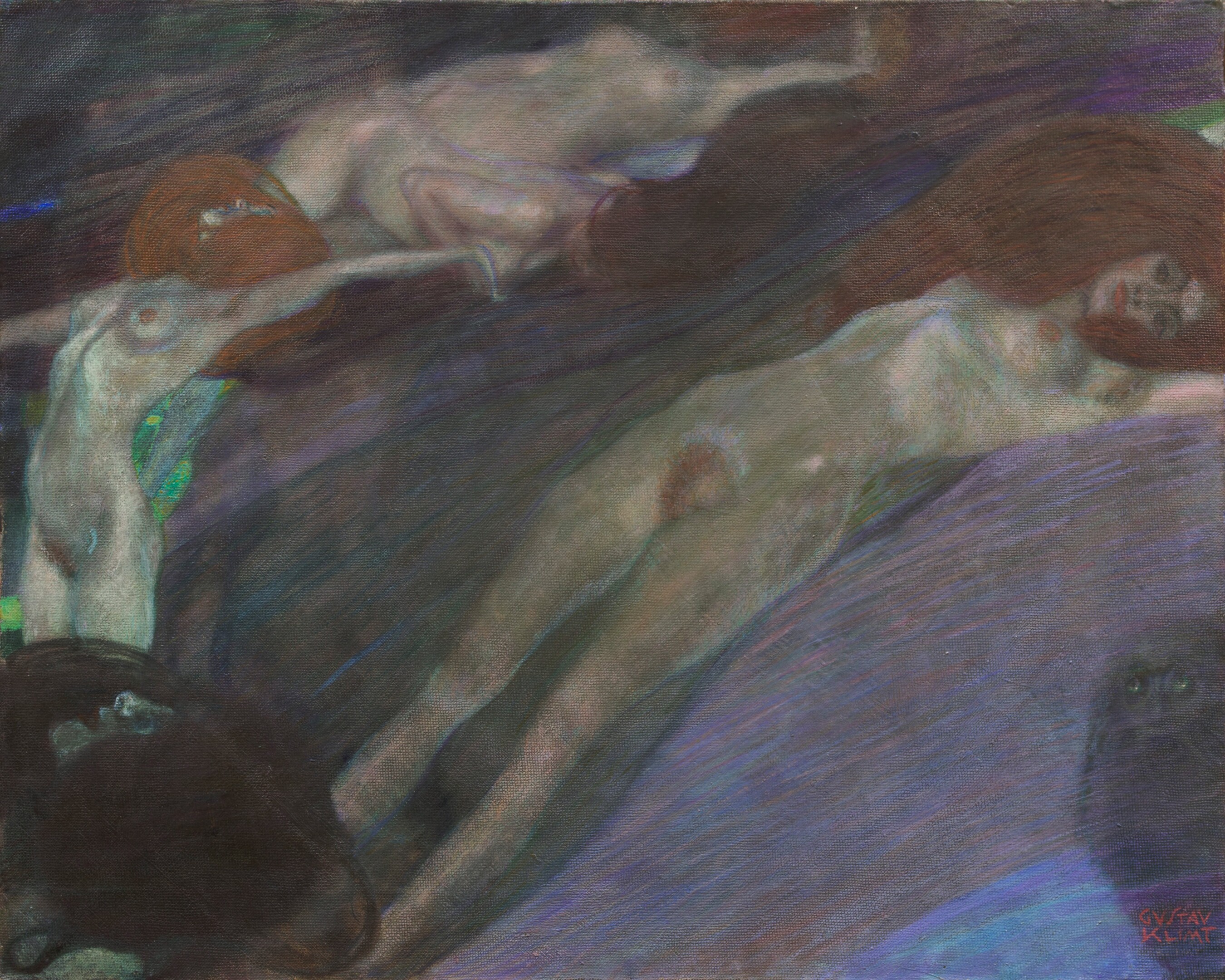
Modern Portraits
Gustav Klimt is known today as the author of impressive and monumental female portraits. But he only began to stand out in this genre at the age of thirty-six, with the portrait of Sonja Knips, followed by the painted likenesses of Serena Lederer and Trude Steiner, with which he increasingly established himself as the Painter of Women.
To the chapter
→
Gustav Klimt: Portrait of Sonja Knips, 1897/98, Österreichische Galerie Belvedere
© Belvedere, Vienna

First Landscapes
From 1897, Klimt continuously worked in the genre of landscape painting. While his initial landscapes were committed to the style of Atmospheric Realism, his later works from the late 19th century onwards were increasingly influenced by Impressionism and Symbolism.
To the chapter
→
Gustav Klimt: A Morning by the Pond, 1899, Leopold Museum
© Leopold Museum, Vienna

Faculty Paintings. Philosophy
The Faculty Painting Philosophy marks Gustav Klimt’s final break with academic traditions in favor of Symbolism. The painting’s first exhibition in 1900 caused a scandal. Following numerous alterations and additions, which were carried out until 1907, the work was destroyed in a fire at Immendorf Castle in 1945.
To the chapter
→
Gustav Klimt: Philosophy, 1900-1907, 1945 in Schloss Immendorf verbrannt, in: Kunstverlag Hugo Heller (Hg.): Das Werk von Gustav Klimt, Vienna - Leipzig 1918.
© Klimt Foundation, Vienna
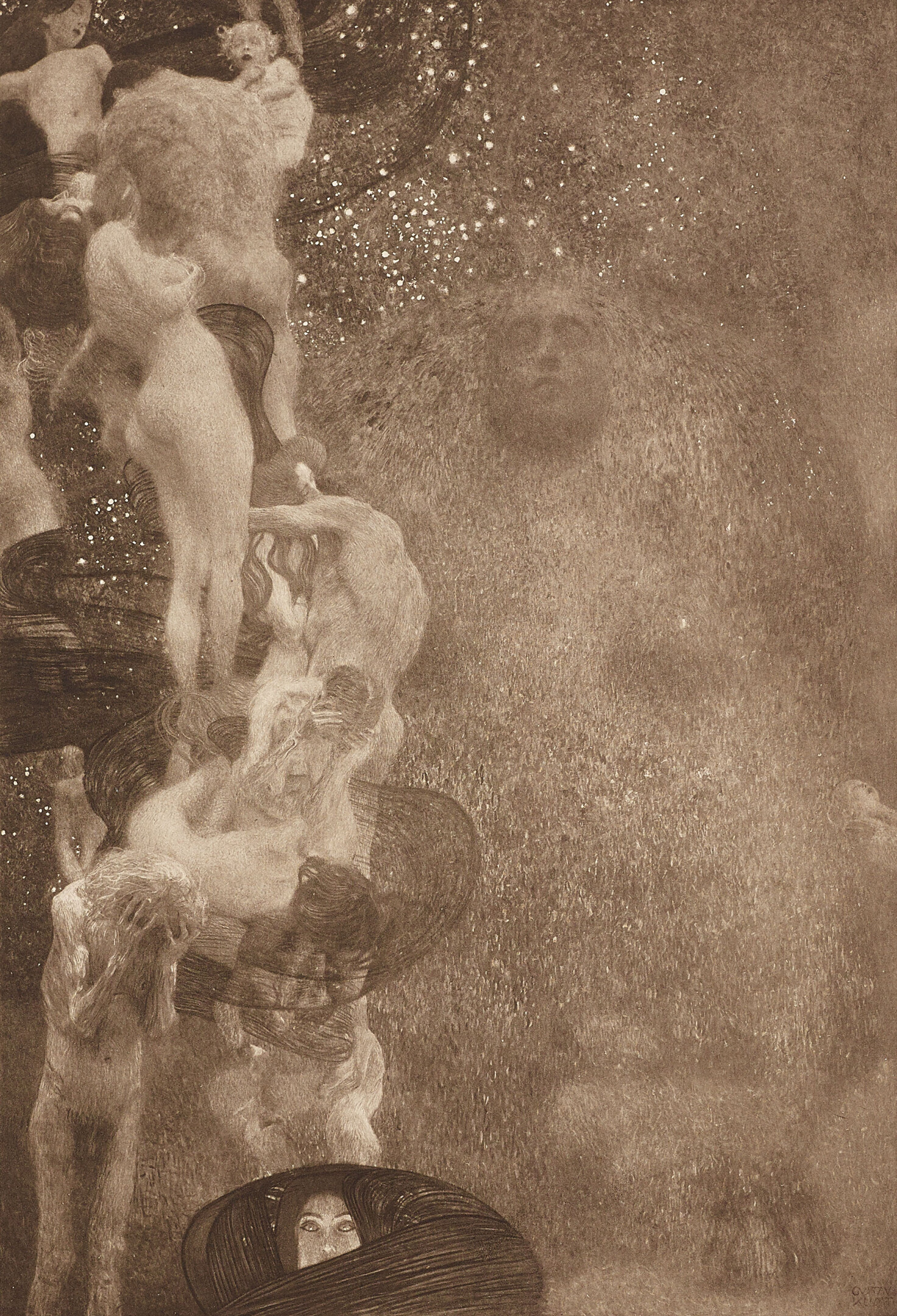
Ver Sacrum and Scandalous Poster
In his capacity as first president of the Vienna Secession, Gustav Klimt exerted a decisive influence on the direction of the new association. He designed the poster for the I. Kunst-Ausstellung der Vereinigung bildender Künstler Österreichs [1st Exhibition of the Vienna Secession], exhibited his own works alongside international avant-garde artists in this presentation, and furnished contributions for the association’s ground-breaking magazine Ver Sacrum.
To the chapter
→
Gustav Klimt: Poster design for the I Secession Exhibition, uncensored version, 1898, private collection
© Klimt Foundation, Vienna

Exhibition Activity
In the late 1890s, Klimt developed from a Historicist decorator into an independent modern artist. The exhibitions of the newly founded Vienna Secession offered Klimt an ideal platform for presenting his increasingly Symbolist works – which, however, also provoked major scandals.
To the chapter
→
Alfons Mucha: Poster of Austria at the World Exhibition in Paris, 1900
© Klimt Foundation, Vienna

Drawings
Shortly before 1900 Gustav Klimt worked in both chalk and ink, which allowed him to create fundamentally different effects with his atmospheric and intimate portraits of ladies on the one hand and his stylized allegories on the other. He was influenced by the movements of Symbolism and Jugendstil, both of which gained ground on the international scene.
To the chapter
→
Gustav Klimt: Bust portrait of a young lady with hat and cape in profile to the left, 1897/98, Leopold Museum
© Leopold Museum, Vienna
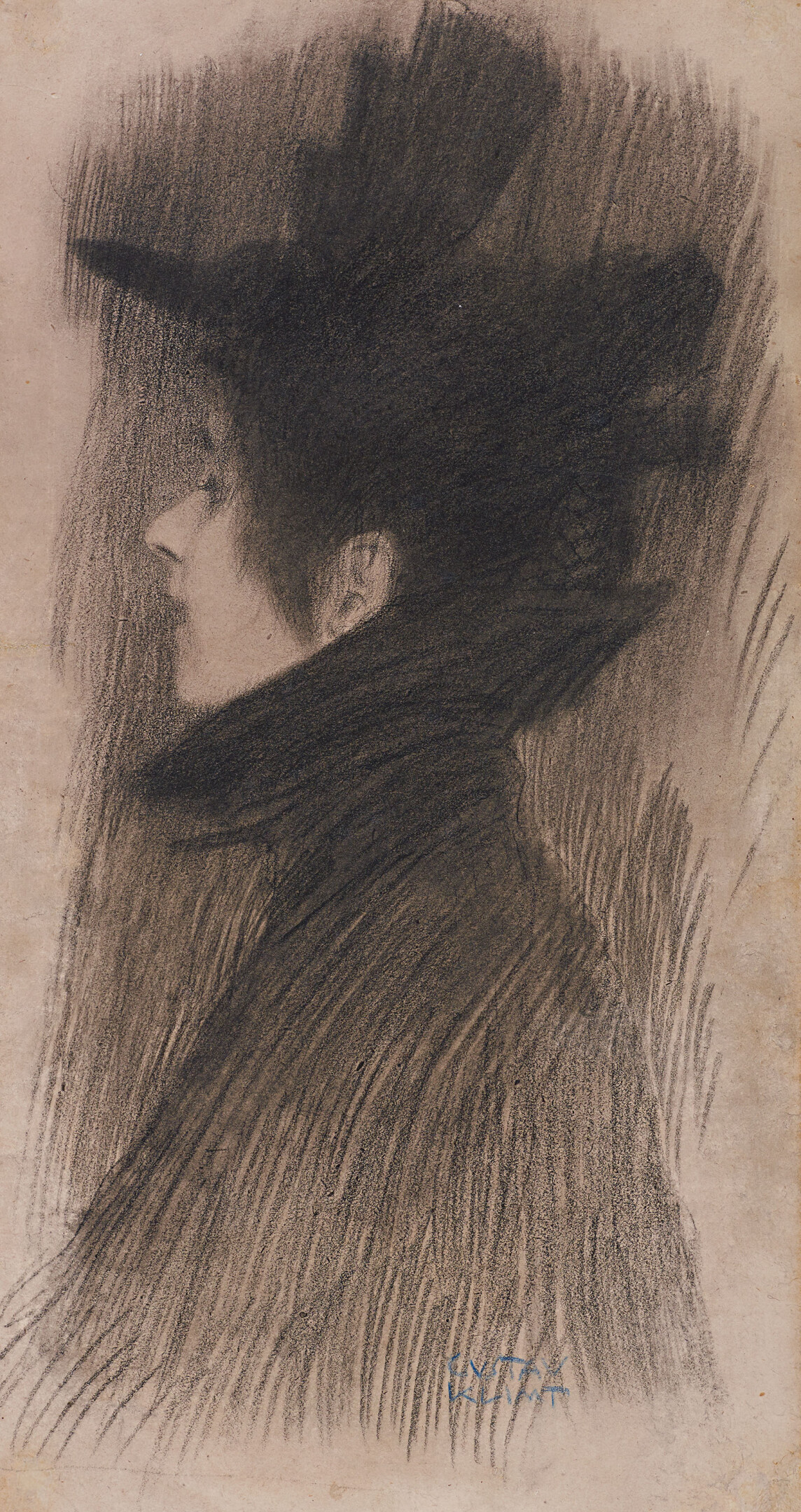



Cradle of Modernism
In the period between the foundation of the Secession in 1897 and the scandal surrounding the Faculty Painting of Philosophy in 1900, Gustav Klimt finally mutated into an exponent of Modernist art. In the Secession’s exhibitions he presented himself with the paintings for Nicolaus Dumba, as well as with Pallas Athene, Nuda Veritas, his monumental female portraits, and his first landscapes.
→
Gustav Klimt: Poster for the first exhibition of the Vienna Association (censored), 1898, Klimt Foundation
© Klimt Foundation, Vienna
Palais Dumba
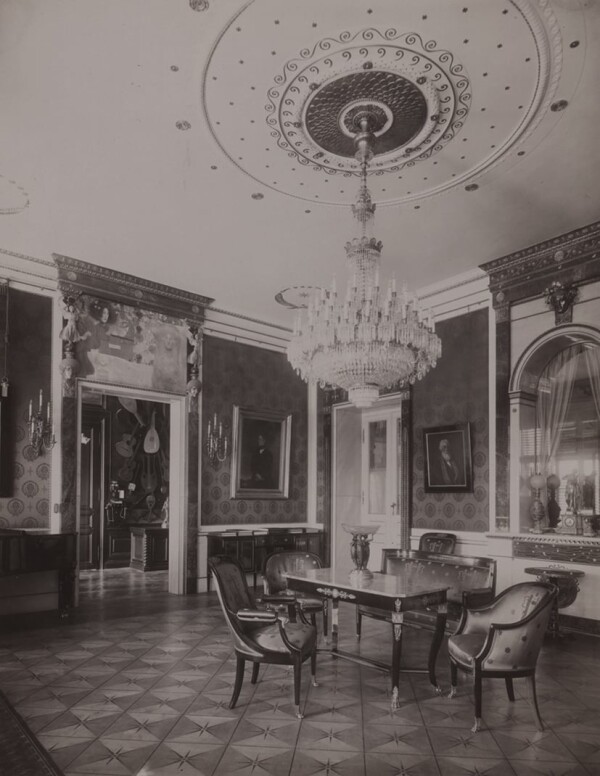
Josef Löwy: Insight into the music salon at Palais Dumba, 1899, MAK - Museum of Applied Arts
© MAK

Gustav Klimt: Design of a wall with door and supraporte of the Dumba music salon, circa 1897, private collection
© Scala Florence
Gustav Klimt was commissioned by the influential patron and industrialist Nicolaus Dumba to decorate his music room with the two supraporte paintings Music and Schubert at the Piano. Though only the oil sketches for the paintings have survived in the original, they clearly illustrate Klimt’s emphatic exploration of International Modernism.
When it came to decorating the representational rooms of his mansion on the Vienna Ringstraße, the eminent commissioner, Schubert collector and patron Nicolaus Dumba wanted to engage only the best Viennese painters of his time. In the 1870s, Hans Makart had already been commissioned to design the office, which was captured for posterity in paintings and photographs. Twenty years later, Dumba tasked the two artists Franz Matsch and Gustav Klimt with the decoration of the dining and music rooms.
The two up-and-coming artists had received the commission already in 1893, but the (architectural) planning and implementation went ahead only four years later. Along with the paintings, Klimt also planned to design the doors, internal elevations and ceiling, for which two relevant drafts have survived (1897, Wien Museum, 1897, private collection).
Reflecting on the extended period of time it took for the music room at Palais Dumba to be completed, the Klimt critic Karl Kraus trenchantly commented in his magazine Die Fackel:
“He [Nicolaus Dumba] had placed the order for the paintings in his music room at a time when Klimt still adhered to the upright style of the Laufberger School, with no more than the odd Makart-esque extravagance strewn in here and there. In the meantime, however, the artist had discovered Khnopff, and – to get the point of the story – has turned into a Pointillist. Naturally, the commissioner has to go along with all of this. Thus, Herr von Dumba has become a Modernist.”

Nicolaus Dumba in his study, around 1890
© Picture Archives and Graphics Department, Austrian National Library
Letters from Gustav Klimt to Nicolaus Dumba from 1896/97
-
 Gustav Klimt: Letter from Gustav Klimt in Vienna to Nicolaus Dumba, 10/31/1896, Austrian National Library
Gustav Klimt: Letter from Gustav Klimt in Vienna to Nicolaus Dumba, 10/31/1896, Austrian National Library
© Department of Manuscripts and Rare Books, Austrian National Library -
 Gustav Klimt: Letter from Gustav Klimt in Vienna to Nicolaus Dumba, 10/31/1896, Austrian National Library
Gustav Klimt: Letter from Gustav Klimt in Vienna to Nicolaus Dumba, 10/31/1896, Austrian National Library
© Department of Manuscripts and Rare Books, Austrian National Library -
 Gustav Klimt: Letter from Gustav Klimt in Vienna to Nicolaus Dumba in Vienna, 02/09/1897, Wienbibliothek im Rathaus, Handschriftensammlung, Partial estate of Nicolaus Dumba
Gustav Klimt: Letter from Gustav Klimt in Vienna to Nicolaus Dumba in Vienna, 02/09/1897, Wienbibliothek im Rathaus, Handschriftensammlung, Partial estate of Nicolaus Dumba
© Vienna City Library, Manuscript collection -
 Gustav Klimt: Letter from Gustav Klimt in Vienna to Nicolaus Dumba in Vienna, 02/09/1897, Wienbibliothek im Rathaus, Handschriftensammlung, Partial estate of Nicolaus Dumba
Gustav Klimt: Letter from Gustav Klimt in Vienna to Nicolaus Dumba in Vienna, 02/09/1897, Wienbibliothek im Rathaus, Handschriftensammlung, Partial estate of Nicolaus Dumba
© Vienna City Library, Manuscript collection -
 Gustav Klimt: Letter from Gustav Klimt in Vienna to Nicolaus Dumba in Vienna, 04/21/1897, Wienbibliothek im Rathaus, Handschriftensammlung, Partial estate of Nicolaus Dumba
Gustav Klimt: Letter from Gustav Klimt in Vienna to Nicolaus Dumba in Vienna, 04/21/1897, Wienbibliothek im Rathaus, Handschriftensammlung, Partial estate of Nicolaus Dumba
© Vienna City Library, Manuscript collection -
 Gustav Klimt: Letter from Gustav Klimt in Vienna to Nicolaus Dumba in Vienna, 04/21/1897, Wienbibliothek im Rathaus, Handschriftensammlung, Partial estate of Nicolaus Dumba
Gustav Klimt: Letter from Gustav Klimt in Vienna to Nicolaus Dumba in Vienna, 04/21/1897, Wienbibliothek im Rathaus, Handschriftensammlung, Partial estate of Nicolaus Dumba
© Vienna City Library, Manuscript collection
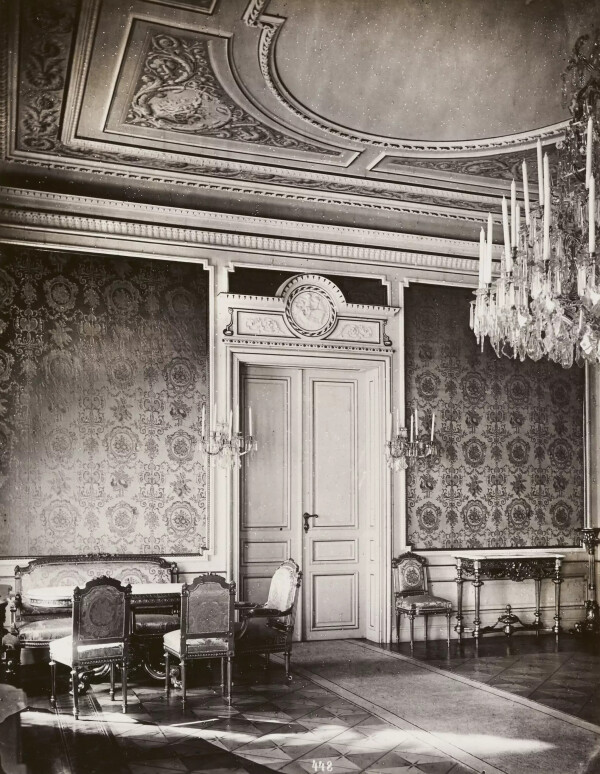
Salon in Palais Dumba, presumably before it was converted into a music salon, around 1890
© Wien Museum
Music and Schubert at the Piano
The two paintings Klimt executed in 1897/98 and 1899 respectively, illustrate his evolution towards Symbolism, Victorian painting and French-Belgian post-Impressionism.
The motifs in the executed painting Music appear much clearer than they do in the preparatory study. The cithara player turns away from the depiction in the painting, resting the instrument on the low wall, with the ornamental background taking up the entire image space. Klimt increasingly dispensed with diffusely painted, post-impressionist elements to accord more space to planar areas. The same tendency can be observed in his painting Schubert at the Piano. In the lost execution of the work, the portrait of the composer is framed by a black door. While the candlelight still shows remnants of Pointillist painting, Gustav Klimt started to develop his own, original style during his work on the two paintings in the second half of the 1890s – that of a planar Jugendstil.
Reviews of Klimt’s Supraporte Paintings
Gustav Klimt presented the commissioned works at the 1st and 4th exhibitions of the Vienna Secession, held in 1898 and 1899. While Music was barely mentioned in the press, the painting Schubert at the Piano was lauded by the majority of critics in 1899. The Austrian author Hermann Bahr even called it “the most beautiful painting ever painted by an Austrian.” A journalist for the newspaper Arbeiter-Zeitung placed the two supraporte paintings into direct comparison:
“The color effects of the two paintings are completely different. While the first one was colorful, radiant, powerful, decorative-fantastical, this one [Schubert at the Piano] is characterized by colors that are duller, duskier and more delicate. In terms of the coloring, the artist has certainly not made things easy for himself. […] The painting is highly subjective, wants to be seen in isolation and requires an unusually profound understanding of the artist’s intentions.”
Schubert at the Piano and Music
-
 Gustav Klimt: Schubert at the Piano (Study), 1896/97, private collection
Gustav Klimt: Schubert at the Piano (Study), 1896/97, private collection
© Leopold Museum, Vienna -
 Gustav Klimt: Schubert at the Piano, 1899, 1945 in Schloss Immendorf verbrannt
Gustav Klimt: Schubert at the Piano, 1899, 1945 in Schloss Immendorf verbrannt
© Klimt Foundation, Vienna -
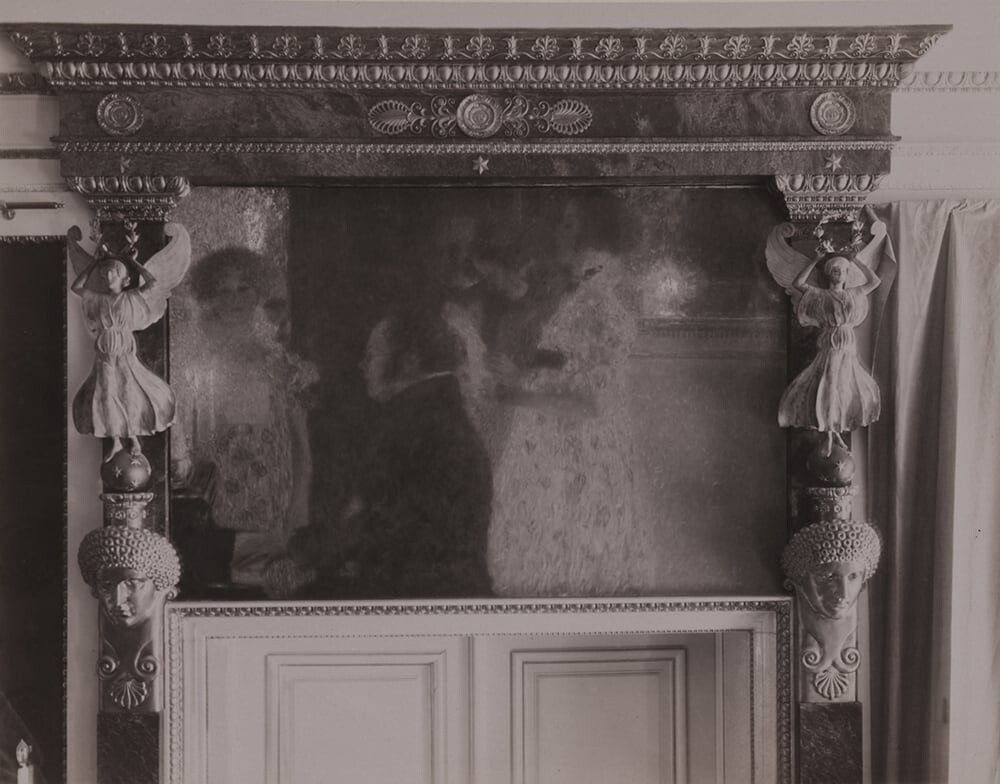 Josef Löwy: Schubert at the piano, 1899, MAK - Museum of Applied Arts
Josef Löwy: Schubert at the piano, 1899, MAK - Museum of Applied Arts
© MAK -
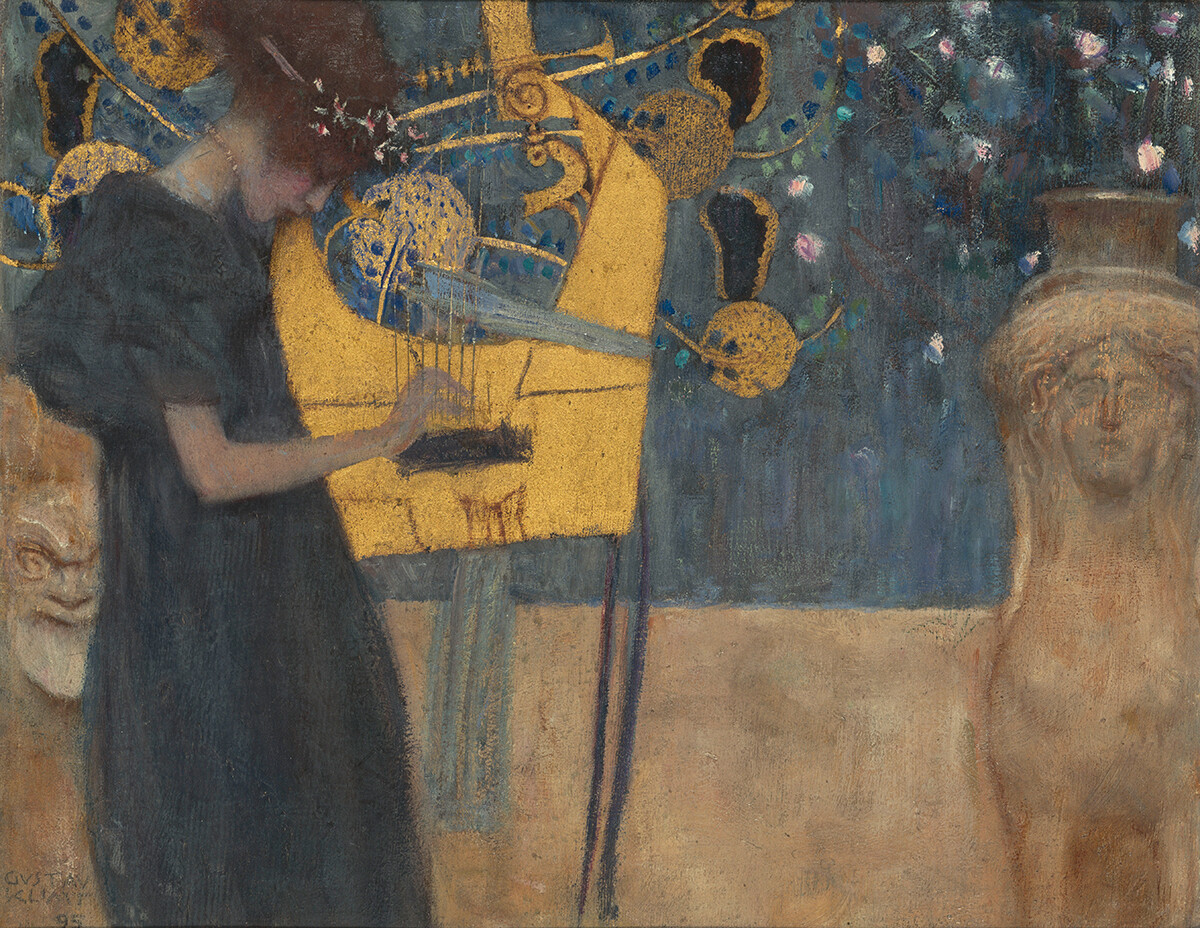 Gustav Klimt: Music (Study), 1895, Bayerische Staatsgemäldesammlungen - Neue Pinakothek München
Gustav Klimt: Music (Study), 1895, Bayerische Staatsgemäldesammlungen - Neue Pinakothek München
© bpk | Bavarian State Painting Collections -
 Gustav Klimt: Music, 1897/98, 1945 in Schloss Immendorf verbrannt
Gustav Klimt: Music, 1897/98, 1945 in Schloss Immendorf verbrannt
© Klimt Foundation, Vienna -
 Josef Löwy: The music, 1899, MAK - Museum of Applied Arts
Josef Löwy: The music, 1899, MAK - Museum of Applied Arts
© MAK
The Works’ Whereabouts
The decor of Palais Dumba has not survived in its entirety, nor have the two supraporte paintings, which were likely destroyed in a fire at Immendorf Castle at the end of World War II. The paintings were exhibited for the last time in 1943. The only impression we have of the works today is from reproductions, several contemporary photographs and the two oil drafts, which are kept at the Bavarian State Painting Collections in Munich and in a private collection (permanent loan at the Leopold Museum, Vienna).
Literature and sources
- Carl Schreder: Erste Kunstausstellung der Secession, in: Deutsches Volksblatt, 22.04.1898, S. 3.
- N. N.: Wiener Briefe, in: (Salzburger) Fremden-Zeitung, 02.04.1898, S. 4.
- Alice Strobl (Hg.): Gustav Klimt. Die Zeichnungen, Band I, 1878–1903, Salzburg 1980, S. 101-103.
- Ludwig Hevesi: Das Heim eines Wiener Kunstfreundes (Nikolaus Dumba), in: Kunst und Kunsthandwerk. Monatsschrift des k. k. Österreichischen Museums für Kunst und Industrie, 2. Jg., Heft 10 (1899), S. 341-365.
- Hermann Bahr: Secession, Vienna 1900, S. 120-121.
- Arbeiter-Zeitung, 21.03.1899, S. 4-5.
- Agnes Husslein-Arco, Alexander Klee (Hg.): Klimt und die Ringstraße, Ausst.-Kat., Lower Belvedere (Vienna), 05.07.2015–11.10.2015, Vienna 2015.
Myths, Fairy-Tales, and an Allegory
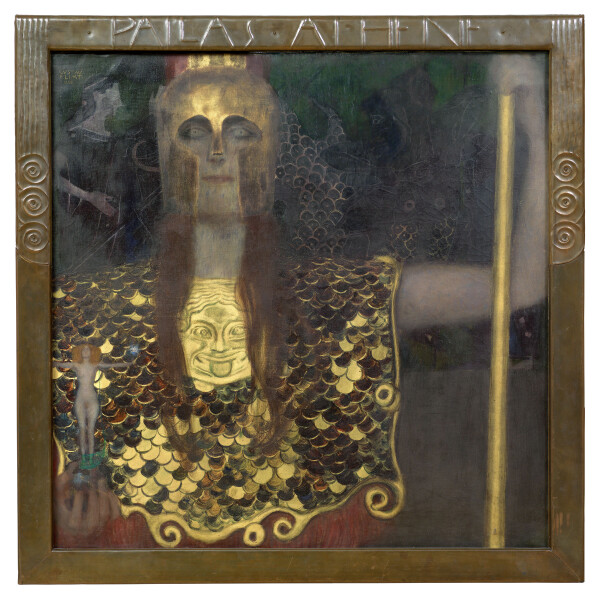
Gustav Klimt: Pallas Athene, 1898, Wien Museum
© Wien Museum

Panel CXI, in: Eduard Gerhard (Hg.): Auserlesene Griechische Vasenbilder, hauptsächlich Etruskischen Fundorts, Band 2, Berlin 1843.
© Heidelberg University Library

Franz Stuck: Poster for the VII. International Art Exhibition in Munich, 1897
© Museum Villa Stuck
By the time Gustav Klimt painted his archaic Pallas Athene, the all-too-earthly allegory of Naked Truth, Nuda Veritas, and the painting Moving Water in 1898/99, he had already developed into a prominent exponent of Modernism. Within a short period of time, Klimt arrived at a “Secessionist” style in which he combined flatness, frontality, and golden luster with the subtle lightness of Post-Impressionist brushwork.
At the “II. Ausstellung der Vereinigung bildender Künstler Österreichs Secession” [“2nd Exhibition of the Association of Austrian Artists Secession”] in November 1898, Gustav Klimt presented, among other pieces, three recent works: Pallas Athene (1898, Wien Museum, Vienna), Moving Water (1898, private collection), and Portrait of Sonja Knips (1897/98, Belvedere, Vienna). All three paintings attracted attention, with Pallas Athene and Moving Water in particular provoking disapproval from almost all commentators.
Pallas Athene
The square-format painting, with its frame designed by Klimt himself, leaves no doubt whom it represents. Klimt had the name of the Greek goddess, “PALLAS ATHENE,” written in capital letters along the upper strip of the frame. In strict frontality, the figure presents herself as a defiant woman: she wears a shiny golden Greek helmet with a nose guard, a shimmering gorgoneion, and a scale cuirass (aegis) over a red chiton. With her left hand she leans on the shaft of a lance. In her right hand, Pallas Athene holds a small Nike supported on a sphere, prefigured in an illustration for Ver Sacrum (March 1898) and strikingly reminiscent of the painting Nuda Veritas (1899, Österreichisches Theatermuseum, Vienna), which would be completed the following year. Her mirror reflects the light like a bluish-white flash against the warm copper and reddish gold of the aegis. Behind Pallas Athena appear shadowy figures and a scaly animal. For this, Klimt borrowed from the painted decoration of a hydria by the Painter of Vatican G 43 (c. 530 BC, The Toledo Museum of Art, Ohio), which shows Hercules fighting Triton.
In the year before he painted Pallas Athena, Gustav Klimt had already chosen the combative patron goddess of the arts as a motif for the Vienna Secession’s first exhibition poster. He and his comrades-in-arms thus referred to the Munich Secession and its poster designed by Franz von Stuck. Stuck was well known in Vienna, having supplied designs for Martin Gerlach’s Allegorien und Embleme [“Allegories and Emblems”] (1882–1884). For the poster of the “VII. Internationale Kunstausstellung” [“7th International Art Exhibition”], the Munich Symbolist had conceived a depiction of Pallas Athene that was to anticipate the solution of Gustav Klimt’s painting in terms of form and content.
Moreover, if one compares Klimt’s depiction of Pallas Athene in the spandrel of the staircase of the k. k. Kunsthistorisches Hofmuseum (today’s Kunsthistorisches Museum, Vienna), which is about eight years older, with the Wien Museum’s picture, the military and aloof appearance of the goddess in the later oil painting is striking.

Gustav Klimt: Greek Antiquity (Athena), 1890/91, Kunsthistorisches Museum
© KHM-Museumsverband
In 1898, such contemporary sources as the magazine Kunst und Kunsthandwerk reported that contemporaries were shocked by the modernity of the goddess of wisdom’s artistic conception and treatment when the painting was first presented:
“Gustav Klimt is completely on that level with a series of new pictures, as little as they have been painted to please the general public (quite the contrary!). His much-discussed Pallas Athene in a golden helmet and cyan and golden scale aegis is a genuine Secessionist goddess, both the figure and its armor radiant with a distinctive poetry of color. This bold work, which ignores all traditions and follows only personal feeling, will continue to be memorable throughout the history of Viennese painting.”
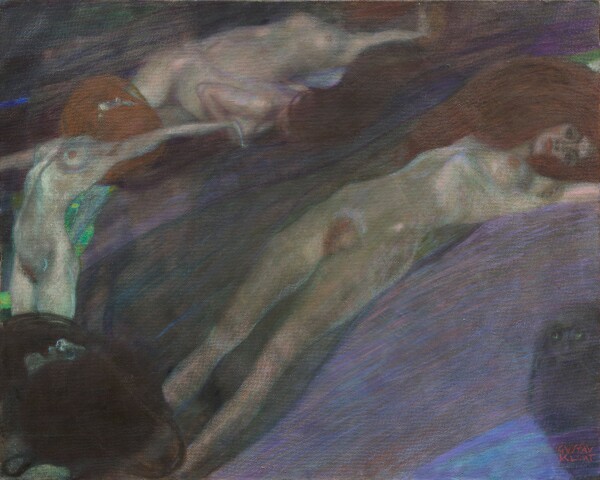
Gustav Klimt: Moving Water, 1898, private collection
© Kallir Research Institute, New York

Gustav Klimt: Fish Blood, in: Vereinigung bildender Künstler Österreichs Secession (Hg.): Ver Sacrum. Organ der Vereinigung bildender Künstler Österreichs, 1. Jg., Heft 3 (1898).
© Klimt Foundation, Vienna
Moving Water
Between 1898 and 1907, Gustav Klimt painted a group of small Symbolist paintings depicting enchanted and mysterious underwater scenes. The work Moving Water, now in a private collection, might have been painted as early as the summer of 1898. It shows the bodies of five women in the nude moving diagonally across the picture plane. Given the title, their postures and hair, as well as the parallel blue and violet lines and the dimmed light, suggest that they could be swimming aquatic creatures. In the lower right corner, a bald creature with green shimmering eyes appears. This is exactly where Gustav Klimt placed his signature in bright red.
In this picture of nameless female creatures, Gustav Klimt revisited the concept of the Faculty Paintings. Today, more than 400 preliminary designs and sketches for the group of these ceiling paintings can still be traced. In them, the painter tried out motifs of human life coming into being, thriving, and perishing, which he visualized in the Faculty Paintings in the form of a rising tower of humans.
The pen and ink drawing The Blood of Fish (1898, private collection), which Klimt created for an issue of the art magazine Ver Sacrum, is also closely related to Moving Water, both compositionally and in terms of content. Conceived with a strong contrast of black and white, the drawing anticipates the procession of swimming and floating women. The scene can be identified as set under water through a large fish head and softly drawn lines and bubbles.
Nuda Veritas
One of Klimt’s most controversial works in 1899 was Nuda Veritas. Measuring 252 by 56.2 centimeters, this tall and narrow painting shows a nude young woman in strict frontality, her appearance stylistically reminiscent of the Belgian painter Fernand Khnopff. White daisies adorn her red mane of hair, and with her right hand she holds up a mirror reflecting the light. Blue and violet lines behind the figure of Naked Truth, the title of the painting translated into German, are interpreted as purifying water or veils. Being motifs borrowed from nature, the two flanking dandelion blossoms, the white flowers in the figure’s hair, and the ornamental lines forming spirals behind the head of Naked Truth are associated with the Secession’s spring symbolism.

Gustav Klimt: Nuda Veritas, 1899, Theatermuseum, Wien
© KHM-Museumsverband
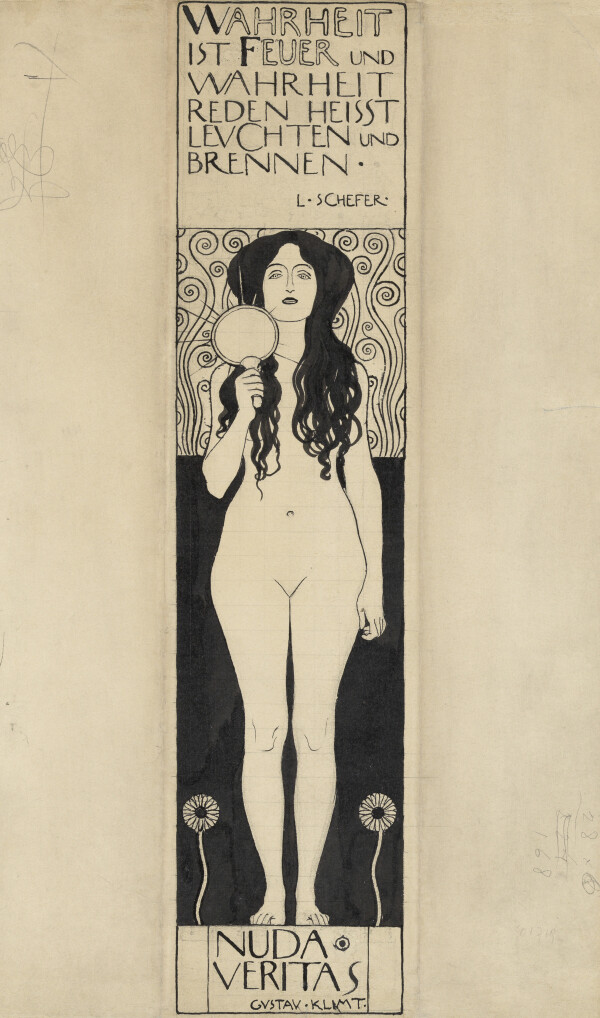
Gustav Klimt: Nuda Veritas, 1898, Wien Museum
© Wien Museum
An adder – possibly a reference to renewal – is wound around the legs of Naked Truth, as they rest firmly on a golden pedestal inscribed “NUDA VERITAS.” Above the head of Naked Truth appears the following phrase in capital letters:
“IF YOUR DEED AND YOUR ART DO NOT PLEASE EVERYONE, PLEASE ONLY A FEW. PLEASING EVERYONE IS FATAL. – SCHILLER.”
A year earlier, in 1898, Gustav Klimt made two ink drawings that are closely related to the painting Nuda Veritas. Envy and a first version of Nuda Veritas (both 1898, Wien Museum, Vienna) were reproduced in the third issue of the first annual volume of Ver Sacrum. Both personifications show the same compositional and formal solution. The figure of Envy appears as an aged woman in a Greek chiton, with the adder around her neck. By contrast, Klimt visualizes the personification of Naked Truth as a youthful woman – but still paired with a quotation by the German Romanticist Leopold Schefer.
In a sketch to be dated between 1897 and 1899 and contained in the Red Sketchbook, a gift from Gustav Klimt to Sonja Knips now in the collection of the Belvedere in Vienna, the painter developed the composition further. He changed the type of woman, probably because Klimt wished to work more intensively with a living model in his painting.
Sketched Genesis of “Nuda Veritas”
-
 Gustav Klimt: Sonja Knips' red sketchbook, 1898, Österreichische Galerie Belvedere
Gustav Klimt: Sonja Knips' red sketchbook, 1898, Österreichische Galerie Belvedere
© Belvedere, Vienna -
 Gustav Klimt: Sonja Knips' red sketchbook, 1898, Österreichische Galerie Belvedere
Gustav Klimt: Sonja Knips' red sketchbook, 1898, Österreichische Galerie Belvedere
© Belvedere, Vienna -
 Gustav Klimt: Sonja Knips' red sketchbook, 1898, Österreichische Galerie Belvedere
Gustav Klimt: Sonja Knips' red sketchbook, 1898, Österreichische Galerie Belvedere
© Belvedere, Vienna -
 Gustav Klimt: Nuda Veritas, 1899, Theatermuseum, Wien
Gustav Klimt: Nuda Veritas, 1899, Theatermuseum, Wien
© KHM-Museumsverband

Bruno Reiffenstein (?): Insight into the Villa Bahr, circa 1901
© Klimt Foundation, Vienna
The work, which was exhibited at the “IV. Ausstellung der Vereinigung bildender Künstler Österreichs Secession” [“4th Exhibition of the Association of Austrian Artists Secession”] (18 March to 31 May 1899), enraged the critics because of the overly slender girl’s body and her reddish cheeks. The prominent quotation from Friedrich Schiller above the sitter’s head was interpreted as an affront by the artist to his audience, which had previously been well disposed toward him but had drifted away in recent years. Klimt’s friend, the author Hermann Bahr, acquired the work and hung it in a special cabinet in the study of his villa.
Today, Nuda Veritas is considered the painting with which Gustav Klimt not only presented himself as an advocate of the concept of the freedom of art, but also ascribed to art a role significant from a socio-politically perspective. The Modernist artist saw himself as a member of a small circle of “chosen ones,” an artistic and social elite whose works were capable of revealing and conveying the truth – which is why Naked Truth holds up a mirror in the direction of the viewer so that one might discover one’s own image in the glaringly bright spot of light.
Literature and sources
- Gottfried Fliedl: Gustav Klimt 1862-1918. Die Welt in weiblicher Gestalt, Cologne 1998.
- Tobias G. Natter (Hg.): Gustav Klimt. Sämtliche Gemälde, Vienna 2012.
- Toni Stoos, Christoph Doswald (Hg.): Gustav Klimt, Ausst.-Kat., Kunsthaus Zurich (Zurich), 11.09.1992–13.12.1992, Stuttgart 1992.
- Ursula Storch (Hg.): Klimt. Die Sammlung des Wien Museums, Ausst.-Kat., Vienna Museum (Vienna), 16.05.2012–07.10.2012, Vienna 2012.
- Alice Strobl: Wasserbilder, in: Alfred Weidinger (Hg.): Gustav Klimt, Munich - Berlin - London - New York 2007, S. 73-92.
- Ludwig Hevesi: Aus dem Wiener Kunstleben, in: Kunst und Kunsthandwerk. Monatsschrift des k. k. Österreichischen Museums für Kunst und Industrie, 1. Jg., Heft 11-12 (1898), S. 409.
Modern Portraits

Gustav Klimt: Portrait of Helene Klimt, 1898, Kunstmuseum Bern, Loan from a private collection
© Kunstmuseum Bern

Gustav Klimt: Portrait of Sonja Knips, 1897/98, Österreichische Galerie Belvedere
© Belvedere, Vienna
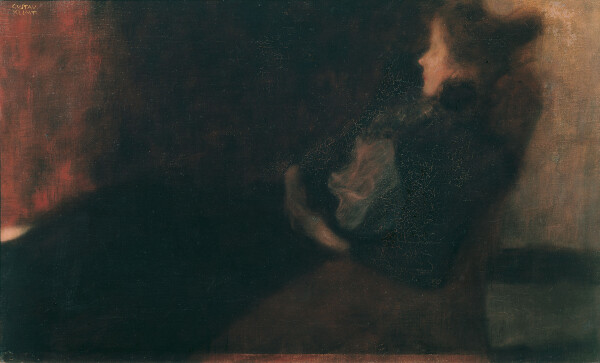
Gustav Klimt: Lady by the Fireplace (at Dusk), 1897/98, Österreichische Galerie Belvedere
© Belvedere, Vienna
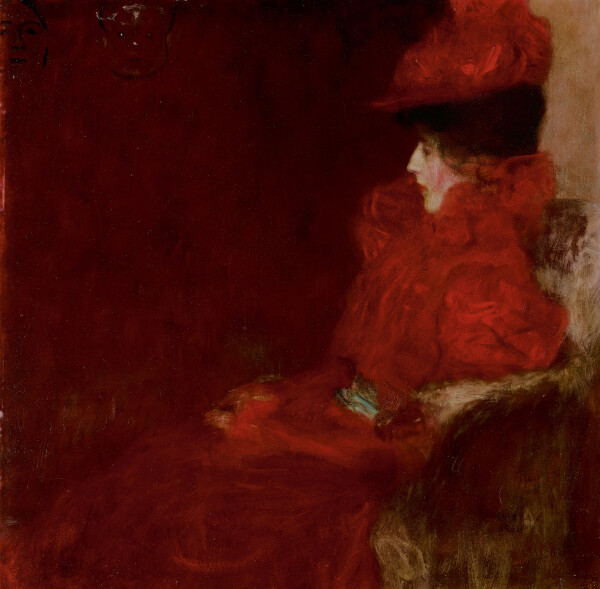
Gustav Klimt: Various Faces (Lady in an Armchair), 1897/98, private collection, courtesy of HomeArt
© Sotheby's

Gustav Klimt: Portrait of Serena Lederer, 1899, The Metropolitan Museum of Art
© The Metropolitan Museum of Art, New York

Gustav Klimt: Portrait of Trude Steiner, 1900, Verbleib unbekannt
© Gallery Welz Salzburg
Gustav Klimt is known today as the author of impressive and monumental female portraits. But he only began to stand out in this genre at the age of thirty-six, with the portrait of Sonja Knips, followed by the painted likenesses of Serena Lederer and Trude Steiner, with which he increasingly established himself as the Painter of Women.
Before Gustav Klimt presented his large-sized Portrait of Sonja Knips (1897/98, Belvedere, Vienna) in the Vienna Secession’s second exhibition and thus appeared as both an important painter of stately portraits and a “modernist,” he turned to his own family.
Helene Klimt
In Portrait of Helene Klimt (1898, private collection) he depicted his niece, who was six years old at the time, in strict profile. He was the guardian of the daughter of his brother Ernst, who had died in 1892, and the latter’s wife, Helene. In the portrait the child resembles a young adult, as any clue as to her young age is erased by the hairstyle and clothing. The smooth, auburn hair is effectively set off against the light-colored background and the high-necked dress, with its colored accents in white and blue. Compared to this portrait of a child, the pastel from 1891, which either depicts her mother or the latter’s sister-in-law (private collection), gives a soft and atmospheric impression.
Around 1896 Gustav Klimt began to take an interest in the painted oeuvres of the Belgian Symbolist Fernand Khnopff and the British-American painter James McNeill Whistler, the portraiture of both of whom would make an impact on him. The Symbolist works helped him to handle such compositional problems as the placement of the figure within the picture space and achieve an atmospheric manner of painting.
Sonja Knips
The Portrait of Sonja Knips (1897/98, Belvedere, Vienna) ranks among Gustav Klimt’s most famous portraits. In what was his first painting of square format, measuring 145 by 146 centimeters, Klimt harked back to stylistic and compositional strategies he had already dealt with from about 1897 onwards in such small-sized oil paintings as Lady by the Fireplace (Dusk) (1897/98, Belvedere, Vienna), Portrait of a Lady in Profile to the Right (1897/98, Allen Memorial Art Museum, Oberlin, Ohio), and Various Faces (Lady in an Armchair) (1897/98, private collection). All of the portraits mentioned show women in strict profile to the right. The tonal coloring and the painting technique suggest the influence of James McNeill Whistler, recalling the latter’s atmospheric, blurring manner. Sonja Knips also faces toward the right, but the strict profile is moderated by the figure’s turning out of the picture. Contemporary reviewers already observed that one half of the picture had remained empty due to the asymmetrical composition. Through the vacant space the painter successfully achieved an exciting contrast between Sonja Knips in her light-colored dress and the diffusely rendered background. It thus seems impossible to locate the sitter in terms of the setting. Solely the white and red lilies above her head might be interpreted as view into a garden or winter garden.
The combination of the motifs of woman and flower was a common topos in the second half of the 19th century that had been introduced by Dante Gabriel Rosetti, among others. The sketchbook bound in red calfskin, which Klimt has put into her hand as a colored accent or indicator of her role as patroness and close friend, now belongs to the collection of the Belvedere in Vienna. As was already observed by his friend Ludwig Hevesi in 1903, by painting Sonja Knips Gustav Klimt created “the first of his modern female portraits.” The narrow frame, the molding of which was fabricated by the metal sculptor Georg Klimt, Gustav Klimt’s second brother, is based on the concept of a Gesamtkunstwerk or total work of art. One of the chararcteristic features of the “modern” approach to portraiture is the empty surface, which took aback many a reviewer, including Carl Schreder of the Deutsches Volksblatt:
“As far as the head goes, this is a very good portrait of a lady, but the treatment of the hands and the dress seem a bit too negligent, and what is more: why this deliberate placement of the figure to the right side of the picture while leaving the left side empty?”
Serena Lederer
With his Portrait of Serena Lederer (1899, The Metropolitan Museum of Art, New York), Gustav Klimt painted the likeness of one of his most loyal devotees. Klimt had already immortalized the twenty-six-year-old art collector and wife of the industrial tycoon August Lederer in the watercolor Auditorium of the Old Burgtheater (1888, Wien Museum, Vienna). The painting, which was executed in 1899 and presented in 1901 at the Vienna Secession’s “X. Ausstellung der Vereinigung bildender Künstler Österreichs Secession” [“10th Exhibition of the Association of Austrian Artists Secession”] shows Serena Lederer as an upright standing figure in a white dress against a white backdrop. Her dark, curly hair, the thick eyebrows, and the black outlined eyes form a vivid contrast. Klimt obviously knew from the very outset that he wished to depict Serena Lederer standing, for the sitter appears like that in all of the surviving drawings.
What strikes one about these preliminary studies is above all the flowing, rhythmical line with which Gustav Klimt sought to capture the drapery. The pose and most of all the high-waisted style of the dress are reminiscent of contemporary fashion photography, which may have served as an inspiration for Klimt in addition to examples of stately portraiture of the past decades. Compared to the transfer sketch (Albertina, Vienna), it becomes obvious that the sweep of the train must have been altered at the very last moment, as it now appears more dynamic. The dress, painted in light blue and white, encloses Serena Lederer’s body without it becoming visible. Using the robe, Klimt suggests a twist of the sitter’s figure, similar to Portrait of Sonja Knips.
When Portrait of Serena Lederer was presented at the “X. Ausstellung der Vereinigung bildender Künstler Österreichs Secession,” it successfully convinced Friedrich Stern, critic of the Neues Wiener Tagblatt, with its “most delicate coloristic effect.” However, the reviewer mocked the “made-up cheeks,” which he had already felt to be completely out of place in Klimt’s Nuda Veritas. As a consequence, August Lederer refused any further exhibition of portraits of family members, which is why Portrait of Serena Lederer was presented in public only once during Gustav Klimt’s lifetime.
Over more than twenty years, Serena Lederer compiled the largest collection of Klimt’s works in Vienna: following her own portrait, she also commissioned the venerated painter with the portraits of her daughter and her mother, Portrait of Elisabeth Lederer (1914–1916, private collection) and Portrait of Charlotte Pulitzer (1917, unknown whereabouts, lost since 1945).
Trude Steiner
In the years 1900 and 1901, Gustav Klimt was asked twice to portray departed members of the family. Portrait of Hermann Flöge sen. on His Deathbed (1899/1900, Belvedere, Vienna) follows the type of realistic depiction of a deceased person while laid out. Portrait of Trude Steiner (1900, unknown whereabouts), on the other hand, suggests that the daughter of Jenny Steiner, who died at the age of thirteen, was still immortalized during her lifetime. The three-quarter-length portrait, which has been considered lost since World War II, features a composition that is similar to that of the painted likeness of Serena Pulitzer Lederer. Trude Steiner is shown standing and en face in a white dress against a light-colored backdrop, her dark hair set off against the atmospherically rendered setting. A bouquet of flowers in her right hand and her hair, which is held together by a bow but nevertheless falls over her shoulders, emphasize the sitter’s youth. In terms of both composition and coloring, the picture resembles James McNeill Whistler’s Symphony in White No. 1: The White Girl (1862, National Gallery of Art, Washington, D.C.), which before 1906, however, Klimt could only have known from reproductions in black and white.
Literature and sources
- Tobias G. Natter (Hg.): Gustav Klimt. Sämtliche Gemälde, Vienna 2012.
- Fritz Novotny, Johannes Dobai (Hg.): Gustav Klimt, Salzburg 1975.
- Alfred Weidinger (Hg.): Gustav Klimt, Munich - Berlin - London - New York 2007.
- Tobias G. Natter, Gerbert Frodl (Hg.): Klimt und die Frauen, Ausst.-Kat., Upper Belvedere (Vienna), 20.09.2000–07.01.2001, Cologne 2000.
- Ludwig Hevesi: Acht Jahre Sezession (März 1897–Juni 1905). Kritik – Polemik – Chronik, Vienna 1906.
- Friedrich Stern: Die Ausstellungssaison, in: Neues Wiener Tagblatt, 16.03.1901.
- Carl Schreder: Zweite Kunstausstellung der Wiener Secession, in: Deutsches Volksblatt (Morgenausgabe), 19.11.1898, S. 1-3.
- Tobias G. Natter: Klimt and Szerena Lederer. Identity and Contradictory Realities of great Art, in: Tobias G. Natter (Hg.): Klimt and the Women of Vienna's Golden Age. 1900–1918, Ausst.-Kat., New Gallery New York (New York), 22.09.2016–16.01.2017, London - New York 2016, S. 34-55.
- Catherine Dean: Klimt, New York 1996.
- Ludwig Hevesi: Feuilleton. Eine Klimt-Ausstellung (Sezession), in: Pester Lloyd, 18.11.1903, S. 2.
- Marian Bisanz-Prakken: Im Antlitz des Todes, Gustav Klimts ‚Alter Mann auf dem Totenbett‘. Ein Porträt Hermann Flöges?“, in: Österreichische Galerie Belvedere (Hg.): Belvedere. Zeitschrift für Bildende Kunst, Heft 1 (1996), S. 20-39.
- Marian Bisanz-Prakken: Gustav Klimt. Alter Mann auf dem Totenbett, in: Gerbert Frodl, Michael Krapf (Hg.): Neuerwerbungen: Österreichische Galerie Belvedere 1992-1999 : Meister von Heiligenkreuz bis Elke Krystufek, Ausst.-Kat., Upper Belvedere (Vienna), 15.09.1999–21.11.1999, Vienna 1999.
First Landscapes
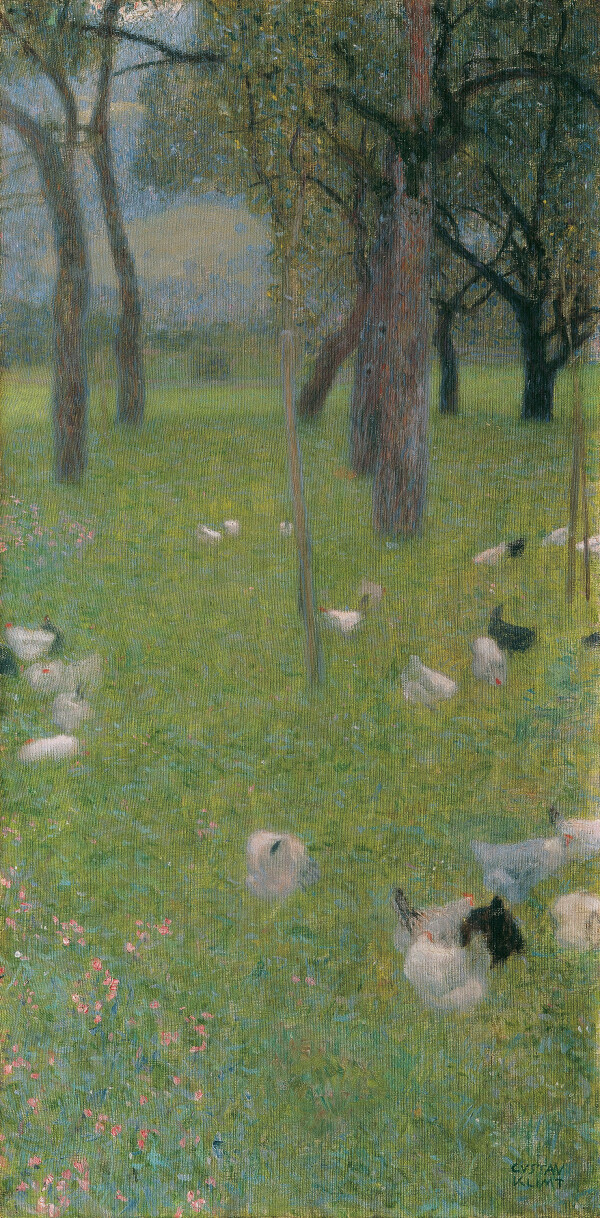
Gustav Klimt: After the Rain (Garden with Chickens in St. Agatha), 1898, Österreichische Galerie Belvedere
© Belvedere, Vienna
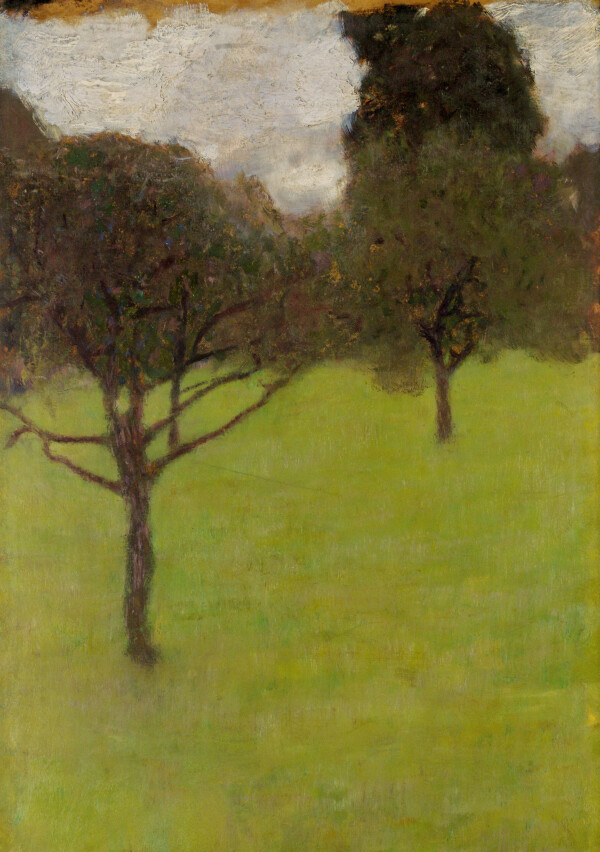
Gustav Klimt: Orchard, circa 1898, private collection
© Leopold Museum, Vienna
From 1897, Klimt continuously worked in the genre of landscape painting. While his initial landscapes were committed to the style of Atmospheric Realism, his later works from the late 19th century onwards were increasingly influenced by Impressionism and Symbolism.
The first nature studies Klimt executed in 1881/82 were still wholly committed to the style of Atmospheric Realism which was prevalent in Austria at the time. After a ten-year gap, during which there are no known landscapes in Klimt’s oeuvre, the artist focused on depictions of cottage gardens. Most of these works were created during his summer sojourns, in 1897 in Fieberbrunn in Tyrol, and in 1898 in St. Agatha in Upper Austria.
The landscape The Crab Apple Tree (1897, whereabouts unknown), which Klimt likely created in 1897 in Fieberbrunn, is now lost. We can thus only speculate about its appearance. Hevesi described the painting as a small landscape study in which “each branchlet has its own sentiment,” and further as a twilight atmosphere of gray and green. What is certain is that the painting was named after the depicted summer apple variety – crab apple – with its characteristically green color. Klimt’s paintings created over the following years increasingly reflected his tendency towards Symbolist atmospheric landscapes.
The privately owned depiction Farmhouse with Roses (1897/98, private collection), which shows the north-eastern facade of a smithy in St. Agatha, is known to us only from a black-and-white photograph. Klimt summered there in 1898 together with the Flöge family. Along with After the Rain (Garden with Chickens in St. Agatha) (1898, Belvedere, Vienna), the painting executed on board Orchard (1898, private collection) and Orchard in the Evening (1898, private collection), it is one of the few landscapes that Klimt created in a narrow portrait format.
In their atmospheric, shimmering blurriness, the orchard landscapes created in 1897/98 show distinct parallels with the works of Fernand Khnopff – whose paintings were shown at the “I. Kunst-Ausstellung der Vereinigung bildender Künstler Österreichs” [“1st Exhibition of the Vienna Secession”] in 1898 – as well as with the shots taken by the art photographer Heinrich Kühne. The open brushwork is reminiscent of Impressionist and Pointillist painting. The phenomenon of color reduction during twilight hours depicted in Orchard in the Evening was especially suitable to convey a mysterious atmosphere. In all his landscapes from this period, Klimt focused on the interplay of light and shadows, and the resulting contrasting color fields, while perspective and spatial depth became less and less important.
While Klimt oriented himself on the innovations of Symbolism and Impressionism in his manner of painting, his formats, which were unusual for Austrian landscape painting, and his high horizons were likely derived from Japanese painting traditions. We know that Klimt took a keen interest in Japanese art, especially in woodcuts. The horizon line, which the artist placed in the upper third of his depictions, served to heighten his increasingly planar, one-dimensional landscape renderings. Klimt would continue to elaborate this carpet-like, almost ornamental concept of nature in his later depictions of cottage gardens.

Gustav Klimt: A Morning by the Pond, 1899, Leopold Museum
© Leopold Museum, Vienna
Klimt’s First Square Landscapes
Klimt’s summer sojourn in Golling near Hallein in 1899, which he spent together with the Flöge family, afforded the artist further opportunities for landscapes and animal depictions. Along with the landscape A Morning by the Pond (1899, Leopold Museum, Vienna), which shows the Egelsee in the early morning, Klimt also painted the work Cows in the Stable (1899, Lentos Kunstmuseum, Linz). Both paintings are among the first examples of nature depictions Klimt created in a square format – the format he would use for all his subsequent landscapes. As documented by a Klimt autograph, the artist searched for these square image sections with the help of a “viewfinder” – a piece of cardboard with a cut out viewing panel.
A Morning by the Pond was the first in a series of landscapes in which Klimt explored the effects of reflections on the water. Once again, the artist placed the horizon close to the upper edge of the painting. His preference for an illusionary depiction of the world through reflections underscores Klimt’s rejection of a naturalistic rendering of reality. While Khnopff had emerged as Klimt’s role model already in previous years, it is blatantly obvious that the Belgian artist’s 1894 painting Still Water. The Ménil Pond (1894, Belvedere, Vienna) served as the direct compositional model for A Morning by the Pond. Claude Monet, too, specialized in such illusionary renderings of nature. It is highly likely that Klimt adopted the idea of a square image format from the French artist, much like the hazy brushstrokes with which he depicted the waves.
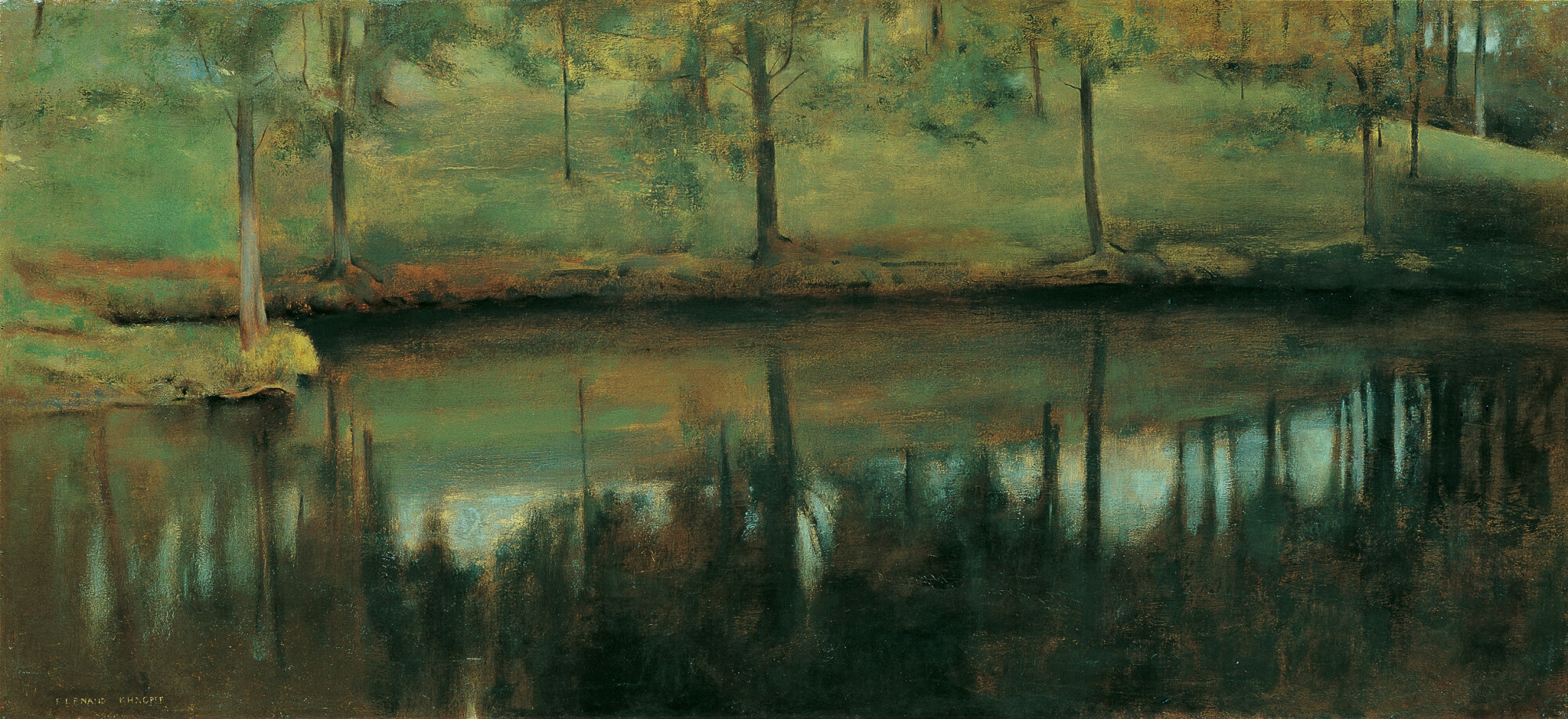
Fernand Khnopff: Unmoved Water. The Pond of Menil, 1894, Belvedere, Vienna
© Belvedere, Vienna
At the “VII. Ausstellung der Vereinigung bildender Künstler Österreichs Secession” [“7th Exhibition of the Vienna Secession”] (1900), Klimt presented not only his Faculty Painting Philosophy but also his landscapes from the two previous years. While the painting for Vienna University caused an art scandal, the Ministry of Culture and Education acquired the work After the Rain (Garden with Chickens in St. Agatha), proving that, despite his controversial modern allegories, Klimt was still highly esteemed as a landscape artist.
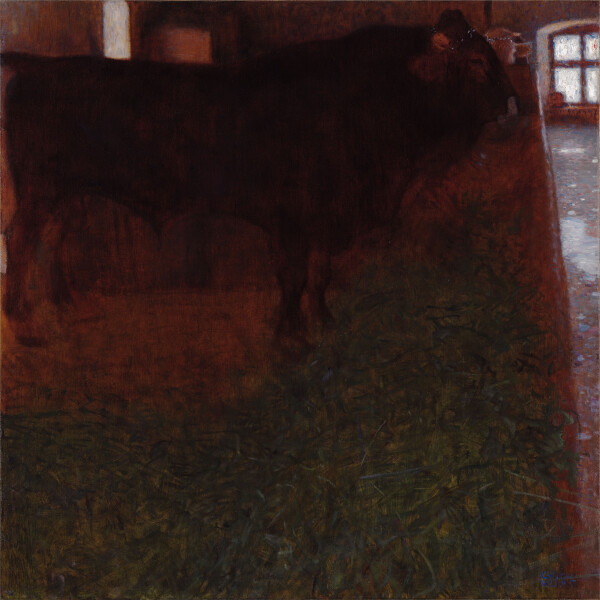
Gustav Klimt: The Black Bull, 1900, private collection
© Leopold Museum, Vienna
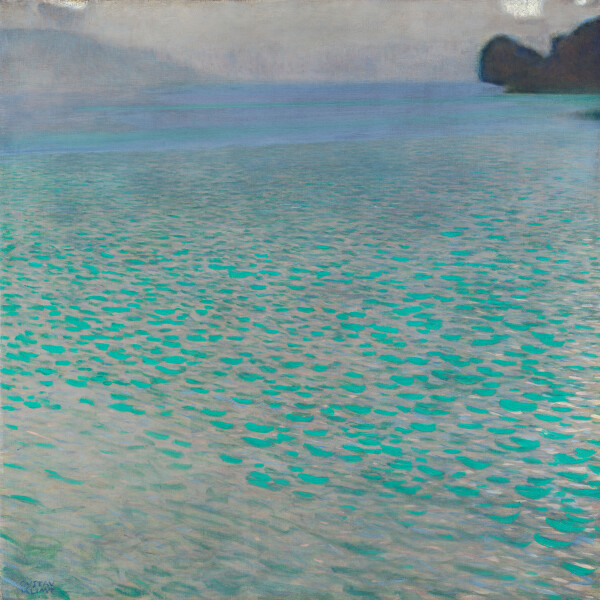
Gustav Klimt: On the Attersee, 1900, Leopold Museum
© Leopold Museum, Vienna
Inspiring Attersee
When Gustav Klimt spent his first summer on the Attersee in 1900 at the invitation of the Paulick family, he created four landscapes and the animal depiction The Black Bull (1900, private collection). Klimt took lodgings at Litzlberg Brewery, and painted his landscapes in the house’s environs. Again, the compositions are dominated by high horizon lines and Impressionist, planar landscape carpets of splendid colors.
In his painting The Marshy Pond (1900, private collection), Klimt captured an oneiric landscape, situated between Symbolism and Impressionism, similar to A Morning by the Pond created a year earlier. The focus was once more on rendering the reflections of the surroundings on the water’s surface.
In his work On the Attersee (1900, Leopold Museum, Vienna), by contrast, Klimt was not interested in reflections of the surroundings but in the oscillating, shimmering colors and quality of the water. He rendered the turquoise waves of the Attersee in an almost Pointillist manner by placing short brushstrokes onto the silver, reflecting water surface. The depiction of the water as an animated color field takes up nearly the entire image space. Hevesi described the painting as follows: “A frame full of lake water, of the Attersee, nothing but short gray and green waves, flowing into each other.”
In his work Farmhouse with Birch Trees (1900, private collection), showing individual tree trunks within a green, planar meadow, Klimt made formal recourses to his earlier depiction After the Rain (Garden with Chickens in St. Agatha).
It wasn’t until the painting The Large Poplar I (1900, Neue Galerie New York, Estée Lauder Collection) that Klimt began to lower his horizon lines and to explore cloud-covered skies. The almost portrait-like staging of individual plants, which is already palpable in his poplar depiction, would come into full bloom eight years later in his painting The Sunflower (1907/08, Belvedere, Vienna), which, with its figural flower interpretation, is believed to be a landscape portrait of Emilie Flöge.
Further contents
Literature and sources
- Alfred Weidinger (Hg.): Gustav Klimt, Munich - Berlin - London - New York 2007.
- Agnes Husslein-Arco, Alfred Weidinger (Hg.): Gustav Klimt 150 Jahre, Ausst.-Kat., Upper Belvedere (Vienna), 13.07.2012–27.01.2013, Vienna 2012.
- Tobias G. Natter, Elisabeth Leopold (Hg.): Gustav Klimt. Die Sammlung im Leopold Museum, Vienna 2013.
- Sandra Tretter, Hans-Peter Wipplinger (Hg.): Gustav Klimt. Jahrhundertkünstler, Ausst.-Kat., Leopold Museum (Vienna), 22.06.2018–04.11.2018, Vienna 2018.
- Tobias G. Natter (Hg.): Gustav Klimt. Sämtliche Gemälde, Vienna 2017.
- Sandra Tretter, Peter Weinhäupl: Treffpunkt Villa Paulick, in: Sandra Tretter, Peter Weinhäupl (Hg.): Gustav Klimt. Sommerfrische am Attersee 1900-1916, Vienna 2015, S. 14-17.
- Alexandra Matzner: Gemalte Gärten. Gustav Klimt und das Gartenbild der Jahrhundertwende, in: Sandra Tretter, Peter Weinhäupl (Hg.): Gustav Klimt. Florale Welten, Vienna 2019.
- Ludwig Hevesi: Acht Jahre Sezession (März 1897–Juni 1905). Kritik – Polemik – Chronik, Vienna 1906, S. 235.
- Brief von Gustav Klimt am Attersee an Maria Zimmermann in Wien, mit skizziertem Motivsucher (um den 03.08.1902). S64/17.
- Stephan Koja: Die Sommer in Litzlberg, in: Stephan Koja (Hg.): Gustav Klimt. Landschaften, Ausst.-Kat., Upper Belvedere (Vienna), 23.10.2002–23.02.2003, Munich 2002, S. 64-70.
- Ostdeutsche Rundschau, 13.03.1900, S. 7.
- Ostdeutsche Rundschau, 15.03.1900, S. 8.
- N. N.: Kunst=Ausstellung, in: Wiener Zeitung, 15.03.1900, S. 8.
Faculty Paintings. Philosophy
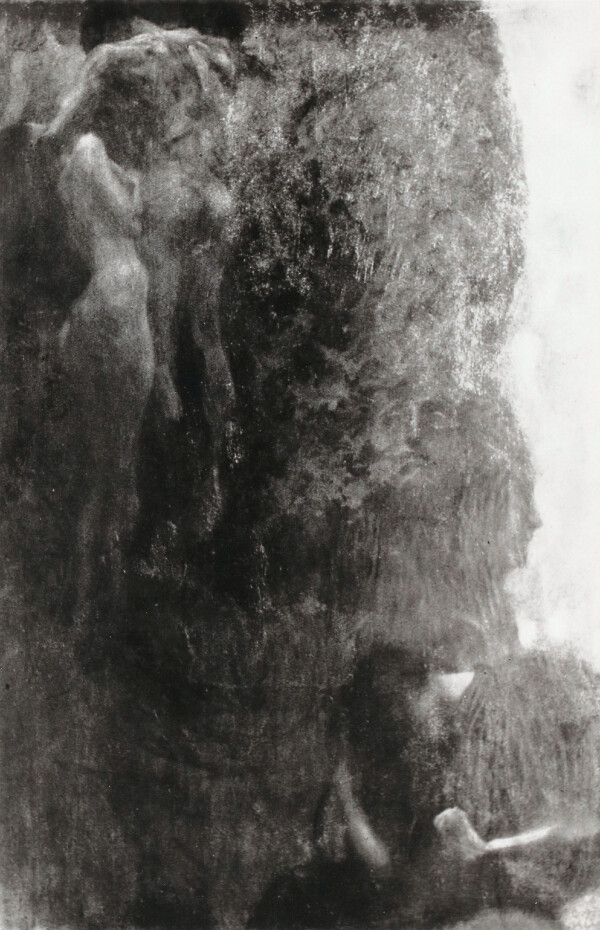
Gustav Klimt: Philosophy (Study), 1898, 1945 in Schloss Immendorf verbrannt
© Gallery Welz Salzburg
The Faculty Painting Philosophy marks Gustav Klimt’s final break with academic traditions in favor of Symbolism. The painting’s first exhibition in 1900 caused a scandal. Following numerous alterations and additions, which were carried out until 1907, the work was destroyed in a fire at Immendorf Castle in 1945.
Genesis of a Monumental Work
Ever since receiving the commission in 1894, Klimt had been creating preparatory sketches and studies for the ceiling paintings for the ceremonial hall of the Imperial-Royal University of Vienna, but he intensified his work especially from 1897 and 1898 onwards. One of the artist’s pads, known as the sketchbook of Sonja Knips, contains around 26 extant compositional sketches which can be ascribed to the Faculty Painting Philosophy (1900–1907, destroyed in a fire at Immendorf Castle in 1945). There are also several surviving sketches for the painted draft for Jurisprudence (1897/98, destroyed in a fire at Immendorf Castle in 1945) and Medicine (1900–1907, destroyed in a fire at Immendorf Castle in 1945).
Along with numerous individual studies and compositional sketches, the artist further created drafts painted in oil, which were examined on 26 May 1898 in an “art committee meeting” held by the academic senate, the artistic committee of the Imperial-Royal University of Vienna and the Imperial-Royal Ministry of Culture and Education. Prior to this examination, the March issue of Ver Sacrum had printed a reproduction with the title “Draft for a Ceiling Painting ‘Hygiea’.” While the painted draft for Medicine has survived (1898, The Israel Museum, Jerusalem), those for Jurisprudence and Philosophy were lost in a fire at Immendorf Castle in 1945, and are known only from photographs.
Gustav Klimt: Seated woman. Study for the oil sketch for "Die Philosophie", 1897/98, The Albertina Museum
© The ALBERTINA Museum, Vienna
At the meeting, Franz Matsch’s designs for the ceiling paintings The Triumph of Light over Darkness and Theology were accepted, while Klimt’s drafts raised several objections. One of the suggestions was for Philosophy to be brighter and rendered more clearly. Especially important was the request for Matsch and Klimt to work more closely together so that the overall effect of the ceiling program would be more harmonious. Resentful of the objections, Klimt wanted to withdraw from the commission, but eventually agreed to the alterations on 3 June 1898, provided that his “artistic freedom” be “respected.” The Ministry of Culture and Education consequently informed Matsch and Klimt of their approval and the payment of the contractually agreed second instalment of their fees on the condition “[…] that the wishes expressed by these two committees [!] be taken into consideration […].”
Seeing as the process of creation of the paintings extended over a long period of time, Klimt’s comprehensive alterations and additions to the Faculty Paintings reflect his artistic development towards Symbolism. In his studies for the personification of knowledge (1897/98, Albertina, Vienna, S 1980: 455; 1897/98, Wien Museum, S 1980: 456), which he placed into the lower right corner of the painted draft for Philosophy, Klimt was likely inspired by Auguste Rodin’s famous work The Thinker (1880/82). Above the figure, we see two heads belonging to a four-headed sphinx, which was probably informed by a marble sculpture (2nd century AD) from the collection of antiquities of the Imperial-Royal Court Museum of Art History (now Kunsthistorisches Museum), which Klimt also depicted in his supraporte painting Music (1897/98, destroyed in a fire at Immendorf Castle in 1945) for Palais Dumba. Klimt positioned a barely visible philosopher opposite the personification of knowledge, while he placed a couple floating skywards above it. This interpretation of the faculty prompted the commissioners’ above-mentioned change requests.
Individual Pages from the Red Sketchbook
-
 Gustav Klimt: Sonja Knips' red sketchbook, 1898, Österreichische Galerie Belvedere
Gustav Klimt: Sonja Knips' red sketchbook, 1898, Österreichische Galerie Belvedere
© Belvedere, Vienna -
 Gustav Klimt: Sonja Knips' red sketchbook, 1898, Österreichische Galerie Belvedere
Gustav Klimt: Sonja Knips' red sketchbook, 1898, Österreichische Galerie Belvedere
© Belvedere, Vienna -
 Gustav Klimt: Sonja Knips' red sketchbook, 1898, Österreichische Galerie Belvedere
Gustav Klimt: Sonja Knips' red sketchbook, 1898, Österreichische Galerie Belvedere
© Belvedere, Vienna -
 Gustav Klimt: Sonja Knips' red sketchbook, 1898, Österreichische Galerie Belvedere
Gustav Klimt: Sonja Knips' red sketchbook, 1898, Österreichische Galerie Belvedere
© Belvedere, Vienna -
 Gustav Klimt: Sonja Knips' red sketchbook, 1898, Österreichische Galerie Belvedere
Gustav Klimt: Sonja Knips' red sketchbook, 1898, Österreichische Galerie Belvedere
© Belvedere, Vienna
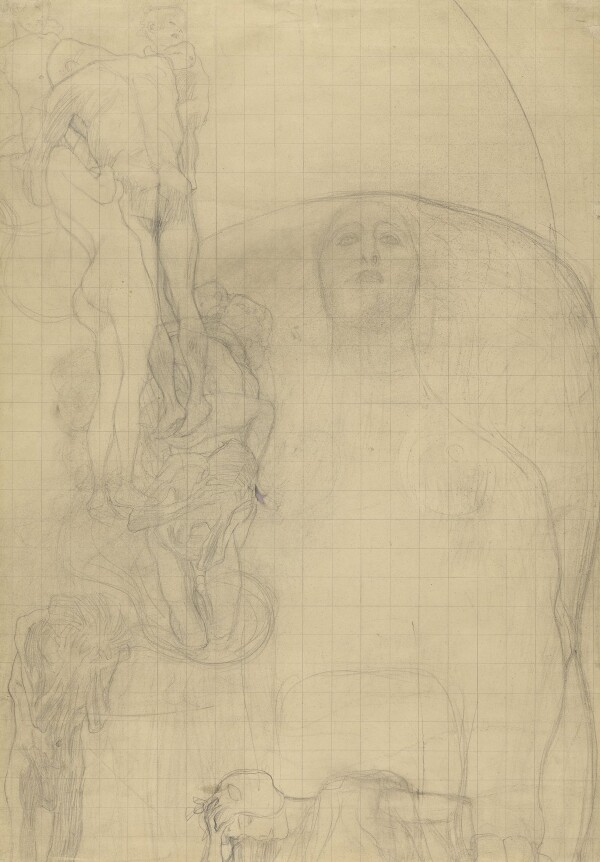
Gustav Klimt: The philosophy (transfer sketch), 1900, Wien Museum
© Wien Museum
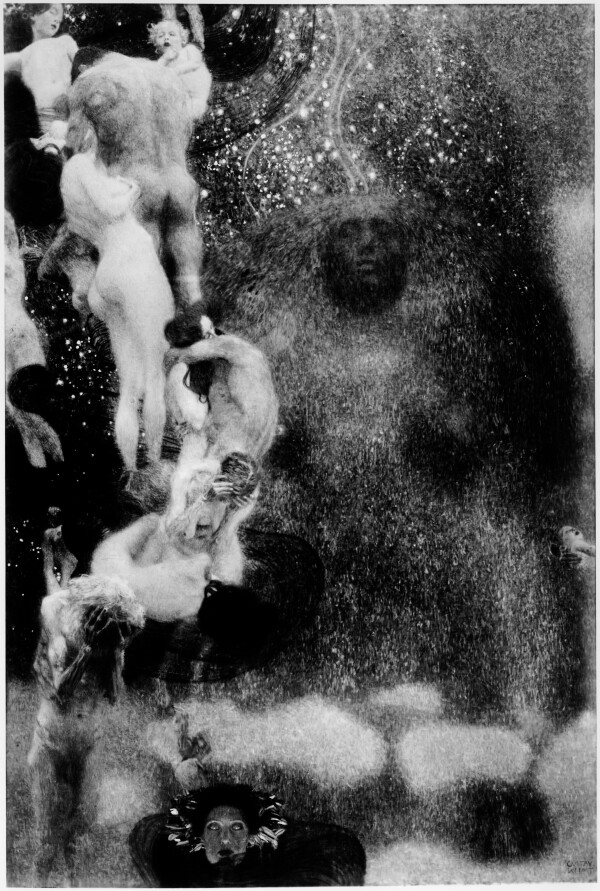
Moriz Nähr: The philosophy, circa 1900, Österreichische Nationalbibliothek, Bildarchiv und Grafiksammlung
© Picture Archives and Graphics Department, Austrian National Library
In his transfer sketch for Philosophy (1900, Wien Museum, S 1980: 477) from around 1899, Klimt developed the composition further. He moved the severely cropped figure of knowledge into the center of the lower picture margin, thus afforded considerably more space to the sphinx depicted from below, and consolidated the stream of people with the addition of further nude figures. The journalist Alfred Deutsch-German visited Klimt in September 1899 in his studio on Josefstädter Straße and described the work as follows:
“He just started a pencil sketch of Philosophy. A tangle of strokes, which fails to reveal a solid shape, it appears baffling to the viewer. An explanation is needed. A vague Mother Nature emerges behind the globe within the hazy azure of twilight. The birth and passing of mankind, the transience of being, is hinted at with allegorical figures. Below this apparition, the artist rendered a firm and tangible personification of knowledge sitting in an armchair.”
The Realization of Philosophy. First Version
As the ceiling of Klimt’s studio at Josefstädter Straße 21 was not high enough to accommodate the Faculty Paintings, which measured 4.3 x 3 meters, he temporarily rented an additional studio. It was situated at nearby Florianigasse 54 on the 4th floor of the joinery and furniture factory Ludwig Schmitt.
Klimt worked on the first version of the Faculty Painting Philosophy until its first public presentation in March 1900 at the “VII. Ausstellung der Vereinigung bildender Künstler Österreichs Secession” [“7th Exhibition of the Vienna Secession”]. In the first edition of the accompanying catalogue, the painting was described as follows:
“Philosophy. One of the five allegorical ceiling paintings for the university’s auditorium. Left group of figures: the creation, fertile existence, passing away. Right: the globe, the mystery of the world. An enlightened figure emerging below: knowledge.”
A reproduction of this version of the painting, photographed by Moriz Nähr, was printed in 1900 in Ver Sacrum. In contrast to the painted draft and transfer sketch, the executed work shows the figure of knowledge as an illuminated head which appears in the lower picture margin and looks out of the depiction in rigid frontality. The stream of people in the left area of the painting consists of nudes of various ages shown in different poses. The sphinx emerges from a nebulous sphere which contemporaries described as a “blurry, oscillating, purple-green universe.” The color accents, which appear white in the black-and-white photograph, were gold-plated stars in the original. In Greek mythology, the sphinx was considered a demon of disaster and destruction. In their works of the 1890s, the European Symbolists often used it to visualize mysteriousness. With his sphinx as a symbol of the “mystery of the world,” Klimt thus followed in the tradition of eminent contemporaries, including Fernand Khnopff and Jan Toorop, whose works were familiar to him from exhibitions and art magazines.
Art Scandal: The “Klimt Affair”
The work Philosophy was first shown at the “VII. Ausstellung der Vereinigung bildender Künstler Österreichs Secession” which opened on 8 March 1900. The painting was displayed in the main exhibition hall and caused a veritable scandal, which also made international waves. The critics faulted Klimt’s unusual interpretation of the philosophical faculty especially for its lack of a clear pictorial and form language, which they felt made the depiction illegible. Without the explanation in the exhibition catalogue, Klimt’s choice of motif, which deviated from classical iconography, was largely incomprehensible to viewers. Yet, Klimt’s Symbolist pictorial language illustrated his evolution from a Historicist decorative painter to the chief Austrian representative of Modernism. The “Klimt Affair” dominated the newspapers’ arts sections for days in late March 1900, and the work Philosophy was derided in numerous caricatures and satirical articles.
Contemporary Caricatures of the Faculty Painting “Philosophy”
-
 Theodor Zasche: Parody of Gustav Klimt's painting "Philosophy", in: Illustrirtes Wiener Extrablatt, 10.04.1900.
Theodor Zasche: Parody of Gustav Klimt's painting "Philosophy", in: Illustrirtes Wiener Extrablatt, 10.04.1900.
© Klimt Foundation, Vienna -
 Theodor Masche: Klimt's philosophy, in: Der Floh, 01.04.1900.
Theodor Masche: Klimt's philosophy, in: Der Floh, 01.04.1900.
© Klimt Foundation, Vienna -
 Association! Kikeriki copies from the latest exhibition, in: Kikeriki. Humoristisches Volksblatt, 05.04.1900.
Association! Kikeriki copies from the latest exhibition, in: Kikeriki. Humoristisches Volksblatt, 05.04.1900.
© Klimt Foundation, Vienna
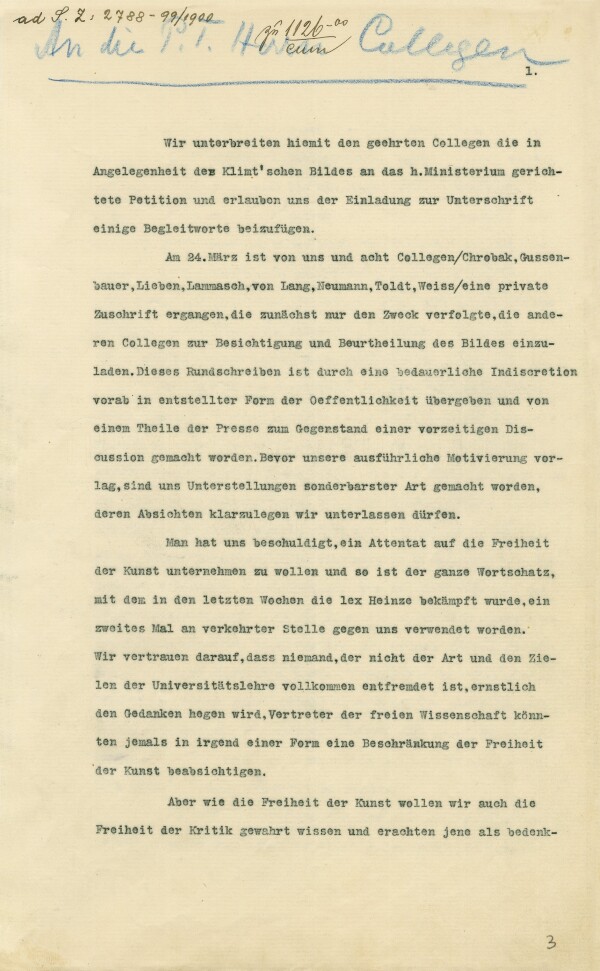
Emil Reisch, Franz Exner, Friedrich Jodl: Circular by Franz Exner, Friedrich Jodl and Emil Reisch, concerning a petition by university professors against the display of the faculty picture "Die Philosophie" (Philosophy), 03/24/1900, Österreichisches Staatsarchiv, Allgemeines Verwaltungs-, Finanz- und Hofkammerarchiv (AVA)
© Austrian State Archives, Vienna
The scandal culminated in a petition started by a group of university professors, led by Franz Exner, Friedrich Jodl and Emil Reisch, which obtained around 70 signatures within only a few days, and which was inadvertently leaked to the press in a “distorted form.” The professors wanted to prevent the work from being hung in its intended place, arguing:
“We are concerned here only with this one particular painting and with the question of whether or not the artist has fulfilled his commission in a satisfactory manner. We do not intend to voice a general opinion on the art movement, which this painting can be ascribed to, nor do we presume to question Klimt’s oeuvre or artistic personality.”
The main points of criticism were Klimt’s choice to depict philosophy as “the mystery of the world, as coming into being and passing away, and as knowledge,” something which – according to the professors – the artist failed to do in an intelligible manner, as well as the unsuitable and inconsistent composition which did not fit in with the auditorium’s architecture. Karl Kraus also weighed in on the controversy:
“If he were to change the title, his philosophy could still be used elsewhere. It is unsuited to the auditorium’s ceiling, if for no other reason, because Mr. Klimt has failed to align his depiction with Matsch’s design for the central painting.”
The commissioner of the Faculty Paintings, Minister Wilhelm von Hartel, adopted a wait and see approach. The Secessionists defended their founding president by deposing a laurel wreath in front of his controversial work on 27 March 1900. Several university professors – among them Prof. Dr. Wickhoff, Emil Zuckerkandl and Edmund Bernatzik – initiated a counter petition, denying the other professors the authority “[…] to influence the decision in a purely artistic matter […].”
Before the end of the Secession exhibition, the work Philosophy was sent on 2 April 1900 to Paris, where the “World’s Fair” was being held. The Vienna Secession had been tasked with curating a room for the Austrian Pavilion, where the monumental work was presented to the public from 12 May 1900. The exhibition’s jury awarded the painting one of twenty gold medals, the “Grand Prix” in the painting division.

Insight into the Paris World's Fair, May 1900 - November 1900
© Heidelberg University Library
Klimt’s work also received some harsh criticism in the international press. The newspaper Allgemeine Zeitung was surprised by the award and described Philosophy as:
“[…] an entirely incomprehensible Symbolist painting. […] This bundle of naked figures, interspersed with eerily grimacing faces, makes viewers run for the hills.”
In 1900, the weekly magazine Die Wage published interviews with Klimt, Carl Moll and members of the ministry of education’s art council and the philosophical faculty, with Klimt justifying himself and stating:
“The painting must first be seen next to the large central painting and its counterpart, ‘Medicine.’ […] It is not impossible that I might make changes to it once it has returned from Paris. But I will never be forced to do so against my artistic convictions.”
Further contents
-
Klimt's Artworks 1889 – 1894 (Decorator of the Ringstraße)Faculty Paintings. Awarding of the Commission
-
Klimt's Artworks 1895 – 1897 (Symbolism in Klimt’s Oeuvre)Faculty Paintings. First Sketches
-
Klimt's Artworks 1901 – 1903 (The Golden Knight and Femmes Fatales)Faculty Paintings. Medicine and Jurisprudence
-
Klimt's Artworks 1904 – 1906 (The Klimt Affair Surrounding the Faculty Paintings)Faculty Paintings. The Klimt Affair
Literature and sources
- Alice Strobl: Die Fakultätsbilder »Medizin« und »Philosophie«, in: Alfred Weidinger (Hg.): Gustav Klimt, Munich - Berlin - London - New York 2007, S. 41-53.
- F. V.: Paris, in: Allgemeine Zeitung (München), 11.06.1900, S. 2.
- Karl von Vicenti: Wiener Frühjahr-Ausstellungen. Secession, in: Die Kunst für Alle. Malerei, Plastik, Graphik, Architektur, 15. Jg. (1899/1900), S. 368-372, S. 396.
- Alfred Deutsch-German: Im Atelier Gustav Klimmt's, in: Neues Wiener Journal, 01.10.1899, S. 4.
- Markus Fellinger, Michaela Seiser, Alfred Weidinger, Eva Winkler: Gustav Klimt im Belvedere. Vergangenheit und Gegenwart, in: Agnes Husslein-Arco, Alfred Weidinger (Hg.): Gustav Klimt 150 Jahre, Ausst.-Kat., Upper Belvedere (Vienna), 13.07.2012–27.01.2013, Vienna 2012, S. 31-281.
- N. N.: Der Kampf um die "Philosophie". Interviews, in: Die Wage. Wiener Wochenschrift, 3. Jg., Heft 14 (1900), S. 224-225.
- Vereinigung bildender Künstler Österreichs Secession (Hg.): Ver Sacrum. Organ der Vereinigung bildender Künstler Österreichs, 1. Jg., Heft 3 (1898), S. 3.
- Vereinigung bildender KünstlerInnen Wiener Secession (Hg.): Ver Sacrum. Mitteilungen der Vereinigung bildender Künstler Österreichs, 3. Jg., Heft 10 (1900), S. 150.
- Abschrift eines Briefes vom k. k. Ministerium für Cultus und Unterricht an Franz Matsch und Gustav Klimt (07/07/1898). S102.3616.3, .
- Abschrift des Akademischen Senats der k. k. Universität Wien von einem Brief des k. k. Ministerium für Cultus und Unterricht an das Rektorat der k. k. Universität Wien mit einer Notiz für die Artistische Comission (05/21/1898). S102.3222.3, .
- Vereinigung bildender Künstler Österreichs Secession (Hg.): Katalog der VII. Ausstellung der Vereinigung bildender Künstler Österreichs Secession, Ausst.-Kat., Secession (Vienna), 09.03.1900–06.06.1900, 1. Auflage, Vienna 1900.
- Rundschreiben von Franz Exner, Friedrich Jodl und Emil Reisch, betreffend eine Petition der Universitätsprofessoren gegen die Anbringung des Fakultätsbildes „Die Philosophie“ (03/24/1900). AT-OeStA/AVA Unterricht Präsidium Akten 266, Zl. 1.126/1900 fol. 3-6, .
- Karl Kraus: Klimt, in: Die Fackel, 1. Jg., Heft 36 (1900), S. 16-20.
- Gegenpetition der Professoren der k. k. Universität Wien an das k. k. Ministerium für Cultus und Unterricht in Wien (presumably late March 1900). AT-OeStA/AVA Unterricht Präsidium Akten 266, Zl. 1.126/1900 fol. 15, .
- Petition der Professoren der k. k. Universität Wien an das k. k. Ministerium für Cultus und Unterricht in Wien (05/05/1900). AT-OeStA/AVA Unterricht Präsidium Akten 266, Zl. 1.126/1900 fol. 7-14, .
- N. N.: Der Protest gegen Klimt's "Philosophie", in: Neue Freie Presse (Abendausgabe), 27.03.1900, S. 1.
- Die Wage. Wiener Wochenschrift, 3. Jg., Heft 14 (1900).
Ver Sacrum and Scandalous Poster

Logo of the Association of Austrian Visual Artists - Ver Sacrum, 1897
© Klimt Foundation, Vienna
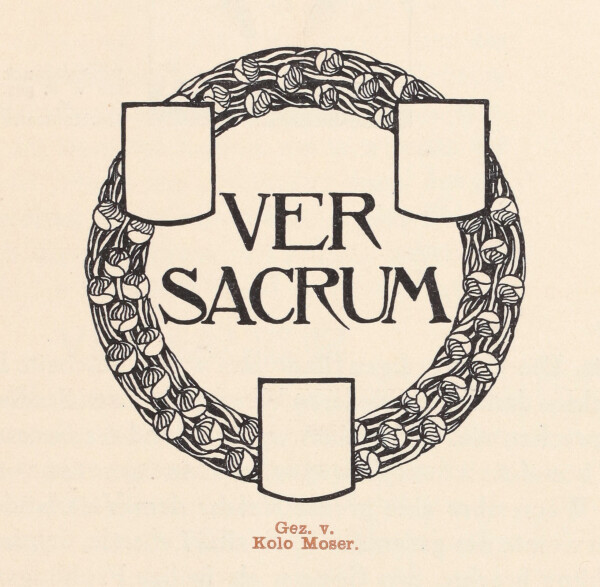
Kolo Moser: Vignette from the first Ver Sacrum booklet, 1898
© Klimt Foundation, Vienna
In his capacity as first president of the Vienna Secession, Gustav Klimt exerted a decisive influence on the direction of the new association. He designed the poster for the "I. Kunst-Ausstellung der Vereinigung bildender Künstler Österreichs" ["1st Exhibition of the Vienna Secession"], exhibited his own works alongside international avant-garde artists in this presentation, and furnished contributions for the association’s ground-breaking magazine Ver Sacrum.
In the 1890s, the desire for artistic renewal led to the foundation of avant-garde artists’ association all across Europe. The bourgeoning ideas of Modernism were disseminated both through the international exhibitions held by the various “Secessions,” and via art periodicals. In Vienna, the most famous founding members of the Association of Austrian Artists Secession included Gustav Klimt, as well as Kolo Moser, Carl Moll and Joseph Maria Olbrich. In 1897, Klimt was elected the association’s first president, with Moll acting as vice president and Rudolf von Alt, who was already 85 years old at the time, as honorary president. The Secession wanted to represent the interests of modern artists, sought to expedite the “revitalization of the Viennese art scene,” to convey international art and to champion the freedom of artistic work. They focused on the idea of the Gesamtkunstwerk, in which artisan craftwork was to be treated on a par with painting, sculpture and architecture.
The Objectives of the Association’s Medium Ver Sacrum
Already during the Secession’s first general assembly on 21 July 1897, it was settled that the association should publish a medium with the title Ver Sacrum. The art periodical was first issued in January 1898 with Gerlach & Schenk publishers. In its first number, the following reasons were given for the magazine’s publication:
“The disgraceful fact that Austria does not have a single illustrated art journal, catering for the country’s particular needs and intended for wide circulation, has made it impossible for artists to promulgate their artistic endeavors. […] As a medium of the Association of Austrian Artists, this magazine is meant to appeal to the population’s appreciation of art, to stimulate, promote and disseminate artistic life and autonomy.”
Alfred Roller acted as the magazine’s editor, while the literary council included Hermann Bahr and Max Burckhard. The latter wrote an opening essay in the first issue, in which he elucidated that the choice of name for the association went back to the Roman tradition of “secessio plebis” – the custom of common people walking out in a demonstration of power to assert their political claims against the patricians. He further explained the journal’s title Ver Sacrum: The “Sacred Spring” also referred to a Roman tradition, which dictated that those who were born in the spring were destined in their adulthood to “leave home to found a new community from their own strength and with their own goals.”
Ver Sacrum, Year 1, Number 1 (1898)
-
 Vereinigung bildender Künstler Österreichs Secession (Hg.): Ver Sacrum. Organ der Vereinigung bildender Künstler Österreichs, 1. Jg., Heft 1 (1898).
Vereinigung bildender Künstler Österreichs Secession (Hg.): Ver Sacrum. Organ der Vereinigung bildender Künstler Österreichs, 1. Jg., Heft 1 (1898).
© Klimt Foundation, Vienna -
 Vereinigung bildender Künstler Österreichs Secession (Hg.): Ver Sacrum. Organ der Vereinigung bildender Künstler Österreichs, 1. Jg., Heft 1 (1898).
Vereinigung bildender Künstler Österreichs Secession (Hg.): Ver Sacrum. Organ der Vereinigung bildender Künstler Österreichs, 1. Jg., Heft 1 (1898).
© Klimt Foundation, Vienna -
 Vereinigung bildender Künstler Österreichs Secession (Hg.): Ver Sacrum. Organ der Vereinigung bildender Künstler Österreichs, 1. Jg., Heft 1 (1898).
Vereinigung bildender Künstler Österreichs Secession (Hg.): Ver Sacrum. Organ der Vereinigung bildender Künstler Österreichs, 1. Jg., Heft 1 (1898).
© Klimt Foundation, Vienna -
 Vereinigung bildender Künstler Österreichs Secession (Hg.): Ver Sacrum. Organ der Vereinigung bildender Künstler Österreichs, 1. Jg., Heft 1 (1898).
Vereinigung bildender Künstler Österreichs Secession (Hg.): Ver Sacrum. Organ der Vereinigung bildender Künstler Österreichs, 1. Jg., Heft 1 (1898).
© Klimt Foundation, Vienna -
 Vereinigung bildender Künstler Österreichs Secession (Hg.): Ver Sacrum. Organ der Vereinigung bildender Künstler Österreichs, 1. Jg., Heft 1 (1898).
Vereinigung bildender Künstler Österreichs Secession (Hg.): Ver Sacrum. Organ der Vereinigung bildender Künstler Österreichs, 1. Jg., Heft 1 (1898).
© Klimt Foundation, Vienna -
 Vereinigung bildender Künstler Österreichs Secession (Hg.): Ver Sacrum. Organ der Vereinigung bildender Künstler Österreichs, 1. Jg., Heft 1 (1898).
Vereinigung bildender Künstler Österreichs Secession (Hg.): Ver Sacrum. Organ der Vereinigung bildender Künstler Österreichs, 1. Jg., Heft 1 (1898).
© Klimt Foundation, Vienna -
 Vereinigung bildender Künstler Österreichs Secession (Hg.): Ver Sacrum. Organ der Vereinigung bildender Künstler Österreichs, 1. Jg., Heft 1 (1898).
Vereinigung bildender Künstler Österreichs Secession (Hg.): Ver Sacrum. Organ der Vereinigung bildender Künstler Österreichs, 1. Jg., Heft 1 (1898).
© Klimt Foundation, Vienna -
 Vereinigung bildender Künstler Österreichs Secession (Hg.): Ver Sacrum. Organ der Vereinigung bildender Künstler Österreichs, 1. Jg., Heft 1 (1898).
Vereinigung bildender Künstler Österreichs Secession (Hg.): Ver Sacrum. Organ der Vereinigung bildender Künstler Österreichs, 1. Jg., Heft 1 (1898).
© Klimt Foundation, Vienna -
 Vereinigung bildender Künstler Österreichs Secession (Hg.): Ver Sacrum. Organ der Vereinigung bildender Künstler Österreichs, 1. Jg., Heft 1 (1898).
Vereinigung bildender Künstler Österreichs Secession (Hg.): Ver Sacrum. Organ der Vereinigung bildender Künstler Österreichs, 1. Jg., Heft 1 (1898).
© Klimt Foundation, Vienna -
 Vereinigung bildender Künstler Österreichs Secession (Hg.): Ver Sacrum. Organ der Vereinigung bildender Künstler Österreichs, 1. Jg., Heft 1 (1898).
Vereinigung bildender Künstler Österreichs Secession (Hg.): Ver Sacrum. Organ der Vereinigung bildender Künstler Österreichs, 1. Jg., Heft 1 (1898).
© Klimt Foundation, Vienna -
 Vereinigung bildender Künstler Österreichs Secession (Hg.): Ver Sacrum. Organ der Vereinigung bildender Künstler Österreichs, 1. Jg., Heft 1 (1898).
Vereinigung bildender Künstler Österreichs Secession (Hg.): Ver Sacrum. Organ der Vereinigung bildender Künstler Österreichs, 1. Jg., Heft 1 (1898).
© Klimt Foundation, Vienna -
 Vereinigung bildender Künstler Österreichs Secession (Hg.): Ver Sacrum. Organ der Vereinigung bildender Künstler Österreichs, 1. Jg., Heft 1 (1898).
Vereinigung bildender Künstler Österreichs Secession (Hg.): Ver Sacrum. Organ der Vereinigung bildender Künstler Österreichs, 1. Jg., Heft 1 (1898).
© Klimt Foundation, Vienna -
 Vereinigung bildender Künstler Österreichs Secession (Hg.): Ver Sacrum. Organ der Vereinigung bildender Künstler Österreichs, 1. Jg., Heft 1 (1898).
Vereinigung bildender Künstler Österreichs Secession (Hg.): Ver Sacrum. Organ der Vereinigung bildender Künstler Österreichs, 1. Jg., Heft 1 (1898).
© Klimt Foundation, Vienna -
 Vereinigung bildender Künstler Österreichs Secession (Hg.): Ver Sacrum. Organ der Vereinigung bildender Künstler Österreichs, 1. Jg., Heft 1 (1898).
Vereinigung bildender Künstler Österreichs Secession (Hg.): Ver Sacrum. Organ der Vereinigung bildender Künstler Österreichs, 1. Jg., Heft 1 (1898).
© Klimt Foundation, Vienna -
 Vereinigung bildender Künstler Österreichs Secession (Hg.): Ver Sacrum. Organ der Vereinigung bildender Künstler Österreichs, 1. Jg., Heft 1 (1898).
Vereinigung bildender Künstler Österreichs Secession (Hg.): Ver Sacrum. Organ der Vereinigung bildender Künstler Österreichs, 1. Jg., Heft 1 (1898).
© Klimt Foundation, Vienna -
 Vereinigung bildender Künstler Österreichs Secession (Hg.): Ver Sacrum. Organ der Vereinigung bildender Künstler Österreichs, 1. Jg., Heft 1 (1898).
Vereinigung bildender Künstler Österreichs Secession (Hg.): Ver Sacrum. Organ der Vereinigung bildender Künstler Österreichs, 1. Jg., Heft 1 (1898).
© Klimt Foundation, Vienna -
 Vereinigung bildender Künstler Österreichs Secession (Hg.): Ver Sacrum. Organ der Vereinigung bildender Künstler Österreichs, 1. Jg., Heft 1 (1898).
Vereinigung bildender Künstler Österreichs Secession (Hg.): Ver Sacrum. Organ der Vereinigung bildender Künstler Österreichs, 1. Jg., Heft 1 (1898).
© Klimt Foundation, Vienna -
 Vereinigung bildender Künstler Österreichs Secession (Hg.): Ver Sacrum. Organ der Vereinigung bildender Künstler Österreichs, 1. Jg., Heft 1 (1898).
Vereinigung bildender Künstler Österreichs Secession (Hg.): Ver Sacrum. Organ der Vereinigung bildender Künstler Österreichs, 1. Jg., Heft 1 (1898).
© Klimt Foundation, Vienna
The magazine became one of the most eminent art periodicals of the time, not just on account of its programmatic content but also due to its innovative graphic design, which reflected the form language of Jugendstil and budding Viennese planar art. From the first year of publication, Gustav Klimt created several illustrations, vignettes and initials for Ver Sacrum, which are testament to his artistic re-orientation and the influence of Symbolism on his work. Along with Klimt’s contribution to book ornamentation, the magazine also reproduced numerous paintings, drawings and works on paper which document his works created at that time.

Poster design, in: Vereinigung bildender Künstler Österreichs Secession (Hg.): Ver Sacrum. Organ der Vereinigung bildender Künstler Österreichs, 1. Jg., Heft 3 (1898).
© Klimt Foundation, Vienna

Gustav Klimt: Poster design for the I Secession Exhibition, uncensored version, 1898, Klimt Foundation, Vienna
© Klimt Foundation, Vienna

Gustav Klimt: Poster design for the I Secession Exhibition, censored version, 1898, Klimt Foundation, Vienna
© Klimt Foundation, Vienna
Poster for the First Exhibition
Since the Secession initially did not have its own exhibition venue, the “I. Kunst-Ausstellung” was held at the flower halls of the Imperial-Royal Horticultural Society on Parkring. The exhibition design was carried out by Hoffmann and Olbrich, with assistance from the “decoration committee” which embarked on the adaptation of the premises on 1 March 1898. The show was advertised through an advance notice, as the poster drawn by Klimt was “not to be posted until just before the exhibition opening.” On 25 March, Franz Xaver von Gayrsperg described the advance notice posters, which have not survived, as “three green signs meant to symbolize the green art of ‘youth’ or the green color of hope in the three fine arts.”
Klimt prepared two different drafts for the first exhibition poster – both with a lot of blank space – which were published in the March issue of Ver Sacrum. For the abandoned poster sketch, Klimt drew a laurel-crowned winged figure, shown from the front, in the upper part which was connected with the written text at the bottom via a snake coiling along the blank area.
For a further poster draft, Klimt also chose a radical composition whose architectural structuring into separate areas dedicated to image and text emphasized the blank space. Along with antique-like typography, he also made recourse to mythological creatures. In the picture frieze above the cornice, Klimt depicted the battle of the naked hero Theseus with Minotaur. On the right edge of the depiction, we discern Pallas Athene who, as goddess of wisdom, strategy, battle, the arts and craftsmanship, and equipped with a spear, a helmet and an apotropaic Gorgoneion shield, watches over the symbolic fight of the Secession against the Künstlerhaus. Thus, the Secessionists’ polemic rhetoric was not only palpable in the articles for Ver Sacrum but continued in the posters. As Theseus rescued the victims from Minotaur, the Secession liberated itself from the constraints of the Künstlerhaus to depart into the “Sacred Spring” and demonstrate its artistic superiority.
“A Cheery Little Piece for Censorship” and “Political Botany”
In the fine drawing (1898, Wien Museum, S 1980: 327) for the poster, Klimt added the exhibition notice, placed the inscription VER SACRUM THESEUS AND MINOTAUR directly next to the battle scene, and covered Theseus’ exposed genitals with a leaf. This version of the poster has survived as a three-colored lithograph in black, red and gold, and as the title page of the May to June 1898 issue of Ver Sacrum.
According to press law, posters – as opposed to printed publications – were subject to pre-censorship. The censors raised objections to the posters – likely already printed at the lithographic printing office of Albert Berger – before the opening of the exhibition. While the records documenting the censorship case have yet to be discovered, it is illustrated by ironic commentaries in the press. Ludwig Hevesi wrote on 25 March in the newspaper Pester Lloyd:
“This Theseus, then, was too naked for the censors! Though concealed by the obligatory fig leaf, even this was considered indecent by the virtuous censors who proscribed the poster. […] Klimt was forced to paint a couple of thick trees to hide Theseus.”
The Ostdeutsche Rundschau described Klimt having to “quickly grow a couple of trees over the already printed battle scene” as a kind of “political botany,” while the paper Das Vaterland called the censorship a “little mishap.” The social democratic Arbeiter-Zeitung attributed the “confiscation” to press prosecutor Dr. Bobies, noting:
“The Secessionists, too, are the kind of filthy pigs who offend common decency by painting a horse without trousers. […] Perhaps Dr. Bobies should go to the trouble of revising the catalogue of the Kunsthistorisches Museum. He will discover dreadful things there, much worse than the Secessionists’ poster.”
Eventually, the exhibition could be advertised with the censored poster, in which trees covered the nakedness – or rather the fig leaf – of Theseus. These tree trunks were probably printed over the already printed lithographs. It is likely that the scandal, handed down through reference works, caused more amusement than outrage among contemporaries.

Franz Holluber: Billboard on Karlsplatz with the 1st Secession poster, 1898, Wien Museum
© Wien Museum
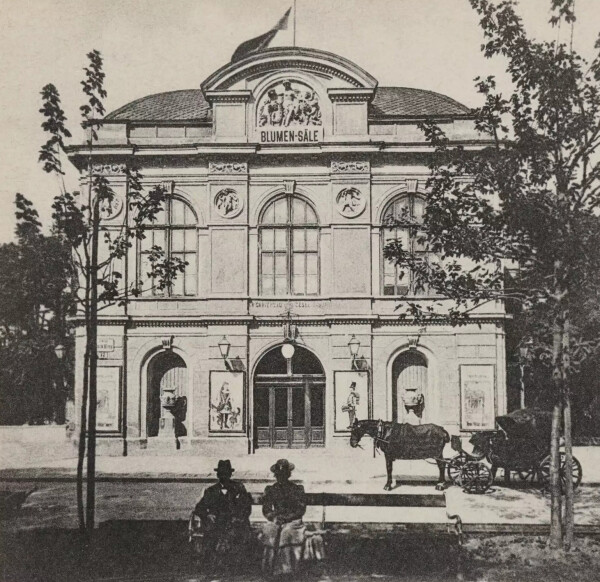
Flower rooms of the k. k. Gartenbaugesellschaft at Parkring 12, 1904
© Wien Museum
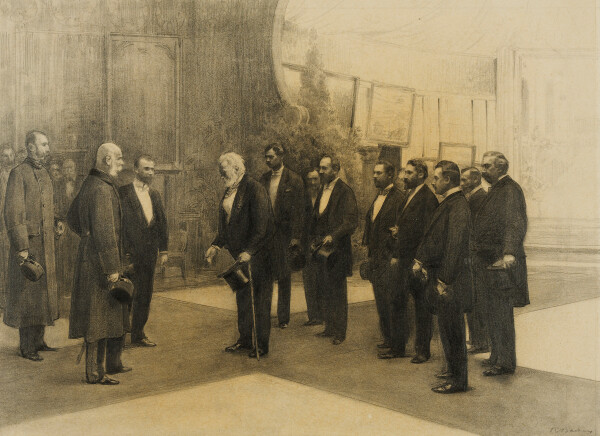
Rudolf Bacher: Emperor Franz Joseph visits the first exhibition of the Vienna Association at the Gartenbaugesellschaft, 1898, Wien Museum
© Wien Museum
The Emperor’s Visit
The “I. Kunst-Ausstellung der Vereinigung bildender Künstler Österreichs Secession” was held at the adapted flower halls of the Imperial-Royal Horticultural Society on Parkring, and opened on 26 March1898. Klimt’s Pallas Athene figure from the poster found further use on the cover of the portrait-format exhibition catalogue. An abridged text from the third number of Ver Sacrum served as the catalogue’s foreword, and outlined the following objectives:
“[…] to offer visitors an elite exhibition of specifically modern artworks. Being able to hold small presentations of select works was one of the main reasons for founding our new association. […] In terms of its artistic arrangement, too, our exhibition is meant to break new ground in Vienna.”
On the morning of 5 April 1898, Emperor Franz Joseph I himself visited the exhibition and expressed his approval of the interesting presentation, which included works by Austrian as well as by international artists, such as Auguste Rodin, Fernand Khnopff, Giovanni Segantini and Constantin Meunier. In a letter, Klimt asked the Emperor after his visit for his “gracious intercession […] through the purchase of artworks […].” In June, the Imperial-Royal Ministry of Culture and Education indeed acquired several works.
His role as the association’s president seemed to have taken up a lot of Klimt’s time. In April 1898, for instance, having to cancel the French lessons he took with Emilie Flöge, he complained to her:
“[…] I must attend a conference – how odious. […] as long as I cannot rid myself of the presidency I unfortunately can’t see things improving.”
Further contents
Literature and sources
- Marian Bisanz-Prakken (Hg.): Heiliger Frühling. Gustav Klimt und die Anfänge der Wiener Secession 1895–1905, Ausst.-Kat., Albertina (Vienna), 16.10.1998–10.01.1999, Vienna 1999.
- Franz Xaver von Gayrsperg: Ausstellungs-Introduktionen. Sezession und Künstlerhaus, in: Neuigkeits-Welt-Blatt, 25.03.1898, S. 10.
- Alexander Klee: Gustav Klimt, in: Stella Rollig, Tobis G. Natter (Hg.): Klimt und die Antike. Erotische Begegnungen, Ausst.-Kat., Orangery (Vienna), 23.06.2017–08.10.2017, Munich 2017, S. 90-99.
- Ursula Storch: 1. und 2. Ausstellung der Secession 1898, in: Ursula Storch (Hg.): Klimt. Die Sammlung des Wien Museums, Ausst.-Kat., Vienna Museum (Vienna), 16.05.2012–07.10.2012, Vienna 2012, S. 134-137.
- Vereinigung bildender Künstler Österreichs Secession (Hg.): Erster Jahresbericht der Vereinigung bildender Künstler Österreichs Secession, Vienna 1899.
- Oskar Pausch: Gründung und Baugeschichte der Wiener Secession. Mit Erstedition des Protokollbuches von Alfred Roller, Vienna 2006.
- N. N.: Secession, in: Wiener Zeitung, 15.06.1898, S. 5.
- N. N.: Politische Botanik, in: Ostdeutsche Rundschau, 08.04.1898, S. 5.
- Brief der Vereinigung bildender Künstler Österreichs an den Kabinettsdirektor Kaiser Franz Josephs I, unterschrieben von Gustav Klimt als Präsident (04/07/1898). ÖStA/HHStA GDPFF Zl. 1403/1898_1, .
- Vereinigung bildender Künstler Österreichs Secession (Hg.): Ver Sacrum. Organ der Vereinigung bildender Künstler Österreichs, 1. Jg., Heft 1 (1898).
- N. N.: Von der Sezession, in: Arbeiter-Zeitung, 02.03.1898, S. 6.
- N. N.: Von der Secession, in: Das Vaterland. Zeitung für die österreichische Monarchie, 25.03.1898, S. IV.
- Neue Freie Presse, 25.03.1898, S. 8.
- Ludwig Hevesi: Die Sezession in Wien, in: Pester Lloyd, 25.03.1898, S. 2.
- Vereinigung bildender Künstler Österreichs Secession (Hg.): Katalog der I. Kunstausstellung der Vereinigung bildender Künstler Österreichs, Ausst.-Kat., Flower rooms of the k. k. Gartenbaugesellschaft (Vienna), 26.03.1898–20.06.1898, Vienna 1898.
- N. N.: Der Kaiser in der Secessionisten-Ausstellung, in: Das Vaterland. Zeitung für die österreichische Monarchie, 05.04.1898, S. 3.
- Rohrpost-Kartenbrief von Gustav Klimt in Wien an Emilie Flöge in Wien (26.04.1898). RL 2367, .
- Vereinigung bildender Künstler Österreichs Secession (Hg.): Ver Sacrum. Organ der Vereinigung bildender Künstler Österreichs, 1. Jg., Heft 5/6 (1898).
- Austrian Posters. Beiträge zur Geschichte der visuellen Kommunikation. www.austrianposters.at/2018/04/14/zensurfall-gustav-klimt/ (09/01/2022).
- Bernhard Denscher: Zensurfall Klimt. Austrian Posters. Beiträge zur Geschichte der visuellen Kommunikation. www.austrianposters.at/2018/04/14/zensurfall-gustav-klimt/ (09/01/2022).
Exhibition Activity

Gustav Klimt: Poster design for the I Secession Exhibition, censored version, 1898, Klimt Foundation, Vienna
© Klimt Foundation, Vienna
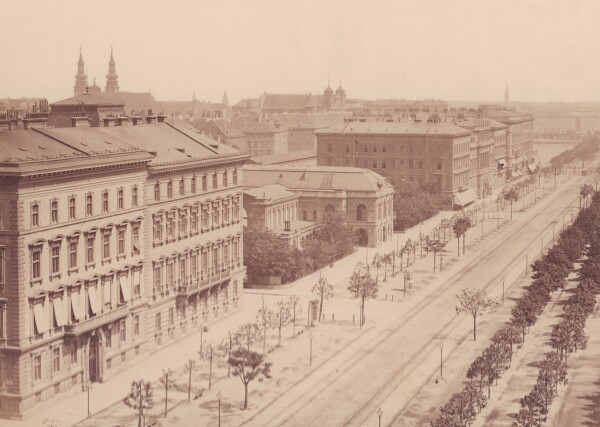
Building of the k. k. Gartenbaugesellschaft on Parkring, around 1900
© Klimt Foundation, Vienna
In the late 1890s, Klimt developed from a Historicist decorator into an independent modern artist. The exhibitions of the newly founded Vienna Secession offered Klimt an ideal platform for presenting his increasingly Symbolist works – which, however, also provoked major scandals.
1st Exhibition of the Vienna Secession
Even before the “I. Kunst-Ausstellung der Vereinigung bildender Künstler Österreichs” [“1st Art Exhibition of the Association of Austrian Artists”] opened its doors, a huge scandal was brought about by Klimt’s exhibition poster, with its nude figure in the style of antiquity. The poster was confiscated and only allowed to recirculate in its censored form. Despite the turmoil, Emperor Francis Joseph I accepted the invitation extended by the exhibition committee, which was headed by Klimt, and visited the exhibition venue at the Gartenbaugesellschaft on 5 April 1898. Nevertheless, the acquisitions expected to be made by the state failed to be realized.
Whereas in the 1890s Gustav Klimt had only figured in the exhibitions of the Vienna Künstlerhaus with individual works, the now-president of the Vienna Secession, which had been founded in 1897, presented himself with an unprecedented spectrum of themes and genres. At the 1898 spring show, Klimt presented three paintings and three drawings. Besides his commissioned work for Nicolaus Dumba – the overdoor Music (1897/98, destroyed by fire at Immendorf Castle in 1945) – Klimt introduced two oil studies – that of an old man, also referred to as The Blind Man (c. 1896, Leopold Museum, Vienna) and a painting entitled By Twilight (c. 1897, unknown whereabouts) (cat. no. 201). The motif of the study By Twilight, which had hitherto been unknown to research, could now be identified as portrait study of a “Lady in Twilight,” thanks to an article in Deutsche Kunst- & Musik Zeitung. As to its appearance, the lost painting seems to have resembled the two works Various Faces (Lady in an Armchair) (1897/98, private collection) and Lady by the Fireplace (at Dusk) (1897/98, Belvedere, Vienna).
In addition to these three oil paintings, Klimt also exhibited two unidentified pastels, as well as his chalk and pencil study for the portfolio Allegorien. Neue Folge: Tragödie [Allegories. New Series: Tragedy] (1896, Wien Museum, Vienna). A “head study” and the painting By Twilight were successfully sold in the course of the exhibition.
For the Vienna Secession’s first exhibition, numerous international works by corresponding members were on view, including the painters Fernand Khnopff, Max Klinger, Giovanni Segantini, and James McNeill Whistler, as well as the sculptors Auguste Rodin and Constantin Meunier.

Joseph Maria Olbrich: Poster of the II Secession Exhibition, 1898
© Klimt Foundation, Vienna
2nd Exhibition of the Vienna Secession
Six months later, the “II. Ausstellung der Vereinigung bildender Künstler Österreichs Secession” [“2nd Exhibition of the Association of Austria Artists Secession”] opened in Joseph Maria Olbrich’s newly erected Secession building. For this group exhibition, which increasingly showcased Viennese artists, Gustav Klimt finished what would become some of his most famous oil paintings. The painter presented as many as seven works. In Portrait of Sonja Knips (1897/98, Belvedere, Vienna) and the portrait of his niece, Portrait of Helene Klimt (1898, private collection), he created his first modern female portraits exhibiting Impressionist features. At Dusk, which would remain unidentified for a long time and had been considered a landscape painting (cat. no. 74), could meanwhile be identified as a small-sized portrait study showing a lady at dusk, thanks to contemporary descriptions. It is probably identical with the work that has been referred to by scholars as Lady by the Fireplace. With its liberal brushwork, Lady by the Fireplace (at Dusk) can be added to the series of modern depictions of women.
Klimt’s Pallas Athene (1898, Wien Museum, Vienna), a painting in the style of antiquity, attracted international attention as early as 1898, when it met with a lack of understanding. With the now-lost landscape The Crab Apple Tree (1897, unknown whereabouts) and the allegory Moving Water (1898, private collection), the Viennese painter followed in the footsteps of the tradition of Symbolist dreamscapes. According to newspaper articles, the painting entitled Silence in the catalog (cat. no. 73) was to be assigned to this category of works painted in some “mystic twilight.” However, the actual appearance of the painting, which was likely bought in the exhibition by Otto Wagner and which was largely positively received by reviewers, remains unknown to this day. Generally, the press observed that Klimt was increasingly influenced by such mystic Symbolists as Fernand Khnopff and Franz von Stuck and distanced himself from his academic education and training. His growing detachment from naturalism, however, also provoked negative critique:
“It is not easy to speak without any reluctance about an artist of such great talent who, at the same time, is such a poseur. His ‘Portrait of a Lady’ shows his best side; his ‘Portrait of a Child’ less so; he is overcome by affectation in his fantasy of ‘Moving Water,’ which becomes even worse in ‘Silence’ and reaches its acme in ‘Pallas Athene.’”

Vienna Association and Naschmarkt, around 1900
© Klimt Foundation, Vienna
Works in the Vienna Secession’s 2nd Exhibition
-
 Gustav Klimt: Moving Water, 1898, private collection
Gustav Klimt: Moving Water, 1898, private collection
© Kallir Research Institute, New York -
 Gustav Klimt: Portrait of Helene Klimt, 1898, Kunstmuseum Bern, Loan from a private collection
Gustav Klimt: Portrait of Helene Klimt, 1898, Kunstmuseum Bern, Loan from a private collection
© Kunstmuseum Bern -
 Gustav Klimt: Portrait of Sonja Knips, 1897/98, Österreichische Galerie Belvedere
Gustav Klimt: Portrait of Sonja Knips, 1897/98, Österreichische Galerie Belvedere
© Belvedere, Vienna -
 Gustav Klimt: Pallas Athene, 1898, Wien Museum
Gustav Klimt: Pallas Athene, 1898, Wien Museum
© Wien Museum -
 Gustav Klimt: Various Faces (Lady in an Armchair), 1897/98, private collection, courtesy of HomeArt
Gustav Klimt: Various Faces (Lady in an Armchair), 1897/98, private collection, courtesy of HomeArt
© Sotheby's

Alfred Roller: Poster of the IV Secession Exhibition, 1899
© Museum für Kunst und Gewerbe Hamburg

Kolo Moser: Poster of the V Secession Exhibition, 1899
© The ALBERTINA Museum, Vienna
4th Exhibition of the Vienna Secession
The catalog accompanying the “IV. Ausstellung der Vereinigung bildender Künstler Österreichs Secession” [“4th Exhibition of the Association of Austria Artists Secession”], which was on from 17 March to 31 May 1899, mentions three works by Klimt: in addition to Schubert at the Piano (1899, destroyed by fire at Immendorf Castle in 1945), the second overdoor for the Dumba music salon, and Nuda Veritas (1899, Österreichisches Theatermuseum, Vienna), the catalog also lists a painting entitled Various Faces (cat. no. 139). The work, which had hitherto been considered lost, could recently be identified thanks to its description in a newspaper article as Lady in an Armchair, which is known in research. It was purchased by one of the brothers of Richard Kralik while the exhibition was still on and thus came into the family’s possession.
While the public received Schubert at the Piano very positively (even the emperor was said to have particularly praised its merits during his visit on 12 April 1899), the nude female personification of ‘Naked Truth’ was criticized. On 27 April 1899, the German art historian and writer Wilhelm Schölermann bluntly summed up his opinion in the periodical Kunstchronik: “Gustav Klimt presents one of his best pictures (‘Schubert’) and one of his worst (‘Naked Truth’).”
5th Exhibition of the Vienna Secession
The hitherto unknown significance of the drawing as an autonomous work of art, as it had also been propagated in the association’s magazine Ver Sacrum, was in the focus of the “V. Ausstellung der Vereinigung bildender Künstler Österreichs Secession” [“5th Exhibition of the Association of Austria Artists Secession”] toward the end of the year 1899. Klimt was represented with nine drawings, comprising primarily study heads and sketches for his Schubert painting. Franz Servaes said about these works in his article in the Neue Freie Presse of 26 November 1899:
“The benchmark for young Vienna is, without doubt, Gustav Klimt. He offers the very combination of grace, vibration, and a sense of style that, it appears to me, makes up the special Viennese essence of a modern sense of art. And he has such a sensitive hand, which, by gently enveloping everything, nevertheless exposes everything most delicately.”
The Imperial-Royal Ministry of Culture and Education acquired Klimt’s drawing Head of a Girl from this exhibition.

Insight into the V Secession exhibition, November 1899 - January 1900
© Klimt Foundation, Vienna

Josef Maria Auchentaller: Poster of the VII Secession Exhibition, 1900, Klimt Foundation, Vienna
© Klimt Foundation, Vienna
7th Exhibition of the Vienna Secession
When presenting the first monumental ceiling painting for the University of Vienna’s Great Hall – Philosophy (1900–1907, destroyed by fire at Immendorf Castle in 1945) – at the “VII. Ausstellung der Vereinigung bildender Künstler Österreichs Secession” [“7th Exhibition of the Association of Austria Artists Secession”] (8 March – 6 June 1900), Klimt provoked one of the fin-de-siècle’s biggest art scandals, which would also arouse international attention. Klimt had worked on the painting until shortly before the exhibition began. We know from multiple sources that he was not satisfied with the painting, which especially held true for the “Head of Knowledge.” The state in which Philosophy was presented in 1900 was thus not yet the final version of the painting, for it is known to have been reworked over the coming years.
Critics mostly complained about the lack of a clear formal and pictorial language and the resulting illegibility:
“They [the works by other artists] conceal [...] the first bad impression Klimt makes with his [...] ‘Philosophy’ when one enters the main hall. The catalog does contain an explanation [...], but I bet a thousand to one that ninety-nine percent of visitors, including myself, will not be able to extract these beautiful things from Klimt’s grotesque color symphony.”
Said description in the catalog, explaining the meaning of the individual pictorial components, shows that Klimt was well aware that his work Philosophy departed from traditional iconography. He had developed his own pictorial idiom as a Symbolist that could not be understood by the general public without further information. Faculty staff from the University of Vienna also complained about the work that was intended to embellish its Great Hall. In March 1900, a large number of professors submitted a petition in which they stood up against the installation of the painting in its place of destination.
In response, the members of the Secession laid a laurel wreath in front of the Faculty Painting on display on 27 March 1900 in order to show their support for Klimt’s monumental modern painting. On 2 April 1900, long before the show closed, the Faculty Painting traveled to the 1900 Paris World’s Fair, after it had been replaced by Theresa Feodorovna Ries’s sculpture The Invincible and a lady’s portrait by Hugo von Habermann.
Despite his scandalous contribution, Klimt succeeded in selling all of the three other works on display. While the two landscapes Orchard in the Evening (1899, private collection) and A Morning by the Pond (1899, Leopold Museum, Vienna) found private buyers, After the Rain (Garden with Chickens in St. Agatha) (1898, Belvedere, Vienna) was purchased by the Ministry of Culture and Education and thus came to be owned by the state. This illustrates that Klimt had by then established himself as a renowned Viennese landscapist featuring Impressionist tendencies.
Apart from Klimt’s works, the presentation comprised paintings by Paul Signac, the “Apostle of Neo-Impressionism,” the Austrian landscapist Eugen Jettel, and the Dutch Symbolist Jan Toorop.
Works in the Vienna Secession’s 7th Exhibition
-
 Moriz Nähr: The philosophy, circa 1900, Österreichische Nationalbibliothek, Bildarchiv und Grafiksammlung
Moriz Nähr: The philosophy, circa 1900, Österreichische Nationalbibliothek, Bildarchiv und Grafiksammlung
© Picture Archives and Graphics Department, Austrian National Library -
 Gustav Klimt: After the Rain (Garden with Chickens in St. Agatha), 1898, Österreichische Galerie Belvedere
Gustav Klimt: After the Rain (Garden with Chickens in St. Agatha), 1898, Österreichische Galerie Belvedere
© Belvedere, Vienna -
 Gustav Klimt: A Morning by the Pond, 1899, Leopold Museum
Gustav Klimt: A Morning by the Pond, 1899, Leopold Museum
© Leopold Museum, Vienna -
 Gustav Klimt: Orchard in the Evening, 1899, private collection, Permanent Loan, Leopold Museum, Vienna
Gustav Klimt: Orchard in the Evening, 1899, private collection, Permanent Loan, Leopold Museum, Vienna
© Leopold Museum, Vienna

Insight into the Paris World's Fair, May 1900 - November 1900
© Heidelberg University Library

Alfons Mucha: Poster of Austria at the World Exhibition in Paris, 1900
© Klimt Foundation, Vienna
Paris World’s Fair
The painting Philosophy, which had met with such hostile criticism in Vienna and was extensively discussed by the international press, was presented at the Paris World’s Fair (14 April – 12 November 1900) in the Austrian section, in a room assigned to the Vienna Secession. Photographs document the work hanging prominently directly opposite the entrance. The exhibition jury, among whose members were Klimt’s colleagues Otto Wagner and Othmar Schimkowitz, honored it with one of twenty gold medals – the “Grand Prix” – in the section of painting. This was unusual, as the association had announced in the run-up to the show that its members would not take part in the competitions. Nevertheless, the work, meanwhile surrounded by scandal, met with little response from both critics and audience:
“How little the French appreciate our modern decoration; not even Klimt’s famous ‘Philosophy’ receives more recognition from the local audience than from Vienna’s university professors.”
In addition to the Faculty Painting, Klimt had sent two of his other masterpieces from that period, Portrait of Sonja Knips (1897/98, Belvedere, Vienna) and Pallas Athene (1898, Wien Museum, Vienna).
By the end of the World’s Fair, the “previously fameless Viennese Secessionist Gustav Klimt,” as he was referred to in the Münchener Allgemeine Zeitung, “had become a well-known figure on the international art scene.”
Literature and sources
- Franz Arnold: Die Ausstellung der Secession, in: Neue Freie Presse (Morgenausgabe), 24.11.1898, S. 3.
- N. N.: Theater und Kunst, in: Das Vaterland. Zeitung für die österreichische Monarchie, 08.04.1898, S. 7.
- N. N.: Die Sezessionsausstellung, in: Ostdeutsche Rundschau, 15.06.1898, S. 9.
- Franz Servaes: In der Secession, in: Neue Freie Presse (Morgenausgabe), 26.11.1899, S. 31.
- von der Hasenheide: Über die Pariser Ausstellung. Berliner Brief, in: Photographische Correspondenz, 37. Jg., Nummer 478 (1900), S. 440.
- Philip Athill: The International Society of Sculptors, Painters and Gravers, in: The Burlington Magazine, 127. Jg., Heft 982 (1985), S. 21-29, S. 33.
- Wilhelm Schölermann: Die Frühjahrs-Ausstellung der Secession und des Künstlerhauses in Wien, in: Kunstchronik. Wochenschrift für Kunst und Kunstgewerbe, N.F., 10. Jg., Heft 23 (1899), Spalte 356.
- Deutsche Kunst- & Musik-Zeitung, 25. Jg., Nummer 9 (1898), S. 100.
- Ludwig Hevesi: Acht Jahre Sezession (März 1897–Juni 1905). Kritik – Polemik – Chronik, Vienna 1906, S. 81.
- Moderne illustrierte Zeitung für Reise und Sport. Theater und Literatur, Kunst, Mode und Fremdenverkehr, 12. Jg., Heft 7 (1912), S. 37.
Drawings

Gustav Klimt: Bust portrait of a young lady with hat and cape in profile to the left, 1897/98, Leopold Museum
© Leopold Museum, Vienna
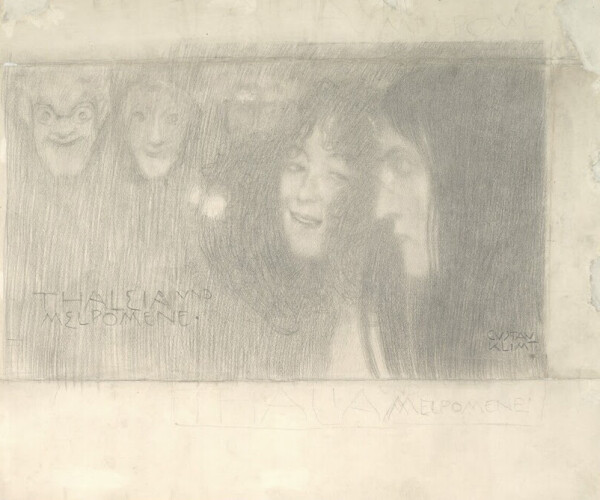
Gustav Klimt: Thaleia and Melpomene, 1898, The Albertina Museum
© The ALBERTINA Museum, Vienna
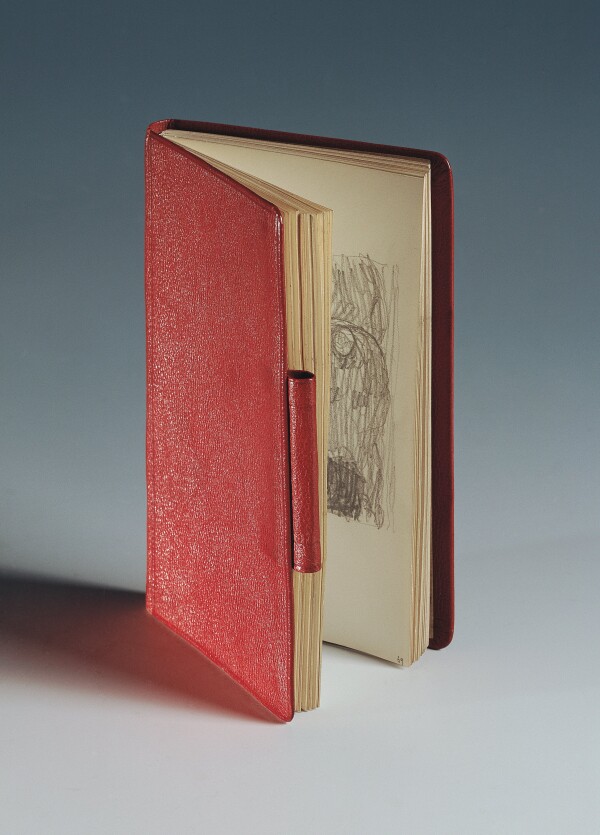
Gustav Klimt: Sonja Knips' red sketchbook, 1898, Österreichische Galerie Belvedere
© Belvedere, Vienna
Shortly before 1900 Gustav Klimt worked in both chalk and ink, which allowed him to create fundamentally different effects with his atmospheric and intimate portraits of ladies on the one hand and his stylized allegories on the other. He was influenced by the movements of Symbolism and Jugendstil, both of which gained ground on the international scene.
Toward the late 1890s, Gustav Klimt switched between a sensual style relying on tonal values for his portraits of ladies, a harsh, linear idiom for his illustrations, and a loose style for his sketches, depending on the function of the drawing in question. Embracing Symbolism and Jugendstil, Klimt also created a number of autonomous drawings in this seminal phase of the Vienna Secession’s founding process.
Portrait Studies and Ladies’ Portraits
Among the drawings executed from 1897 onward, particularly outstanding works include Portrait of a Lady in a Cape and Hat (1897/98, Albertina, Vienna, S 1980: 389), Bust of a Girl in Profile to the Left in a Hat and Cape (1897/98, Leopold Museum, Vienna, S 1980: 390), and Portrait of a Young Woman in an Armchair (1897/98, The J. Paul Getty Museum, Los Angeles, S -). Using mostly black and sometimes red chalk or a soft pencil, Klimt knew how to convey an intimate and atmospheric mood. He staged his female sitters in fashionable attire, modeling their facial features in a soft light. Important inspirations making use of a similar technique of hatching and diffuse light were George Seurat, Eugène Carriere, and Fernand Khnopff.
The drawing Thaleia and Melpomene (1898, Albertina, Vienna, S 1980: 441) is stylistically close to this group of atmospheric ladies’ portraits. It shows the Muses of Tragedy and Comedy with their accompanying theatrical masks and might have been intended as a contribution to the portfolio Allegorien: Neue Folge [Allegories: New Series]. Jan Toroop’s lithograph The Sower (1893, Albertina, Vienna) may have been Klimt’s source of inspiration for the composition of the heads, which are rendered frontally and in profile using vertical hatching.
The Red Sketchbook of Sonja Knips
Only three of Gustav Klimt’s sketchbooks are known to have survived: Klimt immortalized the sketchbook bound in red leather in Portrait of Sonja Knips. In the painting, the patroness holds the red booklet in her hand, having probably received it from Klimt as a gift; it was among her possessions, enclosing a small photograph.
Consisting of 146 pages, the sketchbook contains 76 drawings and diverse notes from the period between 1897 and about 1900. The major part of these entries date from 1898. Klimt jotted down cursory sketches and compositional studies that grant exciting insights into his creative process, from the first idea to the finished work. The studies can be associated with the ink drawing The Blood of Fish (1897/98), the paintings Nuda Veritas (1899, Theatermuseum, Vienna), Moving Water (1898, private collection), The Black Bull (1900, private collection), Judith I (1901, Österreichische Galerie Belvedere, Vienna), Will-o’-the-Wisp (1903, private collection), and the Faculty Paintings. The twenty-six compositional sketches for the Faculty Painting of Philosophy (1900–1907, destroyed by fire at Immendorf Castle in 1945) form a particularly comprehensive group. The booklet also contains several sketches for the painted study of Jurisprudence (1897/98, destroyed by fire at Immendorf Castle in 1945) and for Medicine (1900–1907, destroyed by fire at Immendorf Castle in 1945).
Faculty Paintings
Klimt’s earliest sketches for the ceiling paintings in the assembly hall of the Imperial-Royal University of Vienna date from 1894, the time when the “Künstler-Compagnie” was commissioned with the project, yet Klimt intensified his work on the preliminary studies especially between 1897 and 1898. Making numerous sketches of various poses and life stages, he sought to define the individual figures – nudes frequently viewed from below – while beginning to explore the possibilities of softly swinging outlines.
In addition to the compositional sketches for the Faculty Paintings, the artist also made several designs in the form of oil studies, as well as two transfer sketches for Philosophy (Wien Museum, Vienna, S 1980: 477) and Medicine (Albertina, Vienna, S 1980: 605) dating from around 1900. As Klimt worked on these monumental compositions over an extensive period of time, he made numerous adaptations and additions that document not only the various stages and versions of the Faculty Paintings but also Klimt’s development as an artist. As the artist had abandoned Historicism and more traditional ways of representation, his drawings too exhibited an increasingly Symbolist and modernist style and his new approach to the naked human body, as well as his innovative repertoire of motifs.

Gustav Klimt: Plafond sketch, door and corner solution of the Dumba music salon, circa 1897, Wien Museum
© Wien Museum
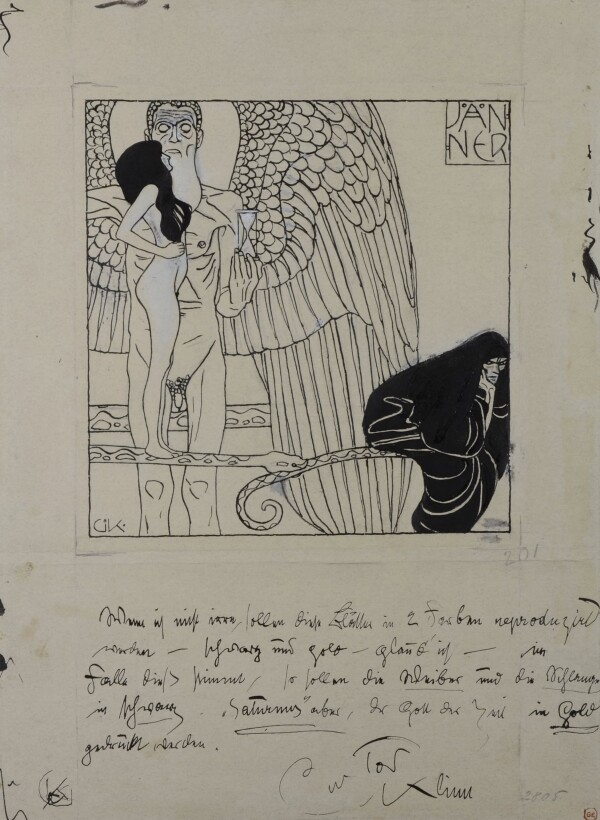
Gustav Klimt: Note by Gustav Klimt on a design for a Ver Sacrum calendar page for the month of January, circa 1900, Museum Georg Schäfer
© Museum Georg Schäfer, Schweinfurt
Designs for the Dumba Music Salon
As goes for the Faculty Paintings, Klimt made his first designs for the project commissioned by Nicolaus Dumba as early as 1894. Two letters from 1897 are proof that by then Klimt had finished “the sketches for the ceiling painting” and “all of the architectural sketches” for the music salon at the Dumba Palace. In his designs (1897, Wien Museum, Vienna, S 1980: 318; 1897, private collection, S 1980: 319) he proposed solutions for the decoration of the walls, doors, and ceiling. From 1898 onward he concentrated on the sketches for the two paintings Music (1897/98, destroyed by fire at Immendorf Castle in 1945) and Schubert at the Piano (1899, destroyed by fire at Immendorf Castle in 1945), which were destined for the overdoors.
Illustrations for Ver Sacrum
A founding member and first president of the Vienna Secession, Gustav Klimt contributed to the association’s magazine Ver Sacrum starting with the first issue. His contributions comprised reproductions of paintings, drawings, and prints, as well as book illustrations, some of which came with the caption “Buchschmuck für V. S. gez. v. Gust. Klimt” [“Book decoration for V. S. drawn by Gust. Klimt”]. In the second issue appeared a colored reproduction of the drawing The Witch (1897/98, Theatermuseum, Vienna, S 1980: 331), which belonged to Hermann Bahr. He described the motif in the Neue Freie Presse in 1922 as “a red witch with hair by Burne-Jones or Rossetti, eyes by Toorop, and a mouth by Khnopff […],” thereby pointing to the English Pre-Raphaelites’ and Belgian Symbolists’ influence.
For the March issue of the year 1898, which was dedicated to Gustav Klimt, he also tried his hand at the genre of book decoration, contributing the vignettes, initials, and illustrations. He partly prepared these illustrations in studies, working in a two-dimensional style reduced to the outlines. This stylistic approach, the upright rectangular formats, and the motifs were inspired by Japanese prints, antique vase painting, and Aubrey Beardsley’s highly stylized graphic oeuvre. The calendar sheet for the month of January (1900, Museum Georg Schäfer, Schweinfurt, S 1980), which, printed in black and gold, appeared in the first issue of the fourth year of Ver Sacrum in 1901, also follows in this tradition.
Literature and sources
- Marian Bisanz-Prakken (Hg.): Gustav Klimt. Die Zeichnungen, Ausst.-Kat., Albertina (Vienna), 14.03.2012–10.06.2012; Getty Center (Los Angeles), 03.07.2012–23.09.2012, Munich 2012.
- Marian Bisanz-Prakken: Klimts zeichnerisches Universum: Grundhaltungen – Seelenstimmungen, in: Tobias G. Natter (Hg.): Gustav Klimt. Sämtliche Gemälde, Vienna 2012, S. 370-455.
- Alice Strobl (Hg.): Gustav Klimt. Die Zeichnungen, Band I, 1878–1903, Salzburg 1980.
- Christian M. Nebehay: Gustav Klimt. Das Skizzenbuch aus dem Besitz von Sonja Knips, Vienna 1987.
- Hermann Bahr: Klimt, in: Neue Freie Presse, 16.07.1922, S. 1-2.
- Franz Smola, Fritz Koreny (Hg.): Linie und Form. 100 Meisterzeichnungen aus der Sammlung Leopold, Ausst.-Kat., Leopold Museum (Vienna), 23.05.2014–20.10.2014, Vienna 2014.
- Alice Strobl (Hg.): Gustav Klimt. Die Zeichnungen, Band IV, 1878–1918, Salzburg 1989.
- Belvedere Sammlung Online. Rotes Skizzenbuch. sammlung.belvedere.at/objects/9997/rotes-skizzenbuch (09/01/2022).
- Brief von Gustav Klimt in Wien an Nicolaus Dumba in Wien (09.02.1897). H.I.N. 54.768, .
- Brief von Gustav Klimt in Wien an Nicolaus Dumba in Wien (21.04.1897). H.I.N. 54.767, .




















































